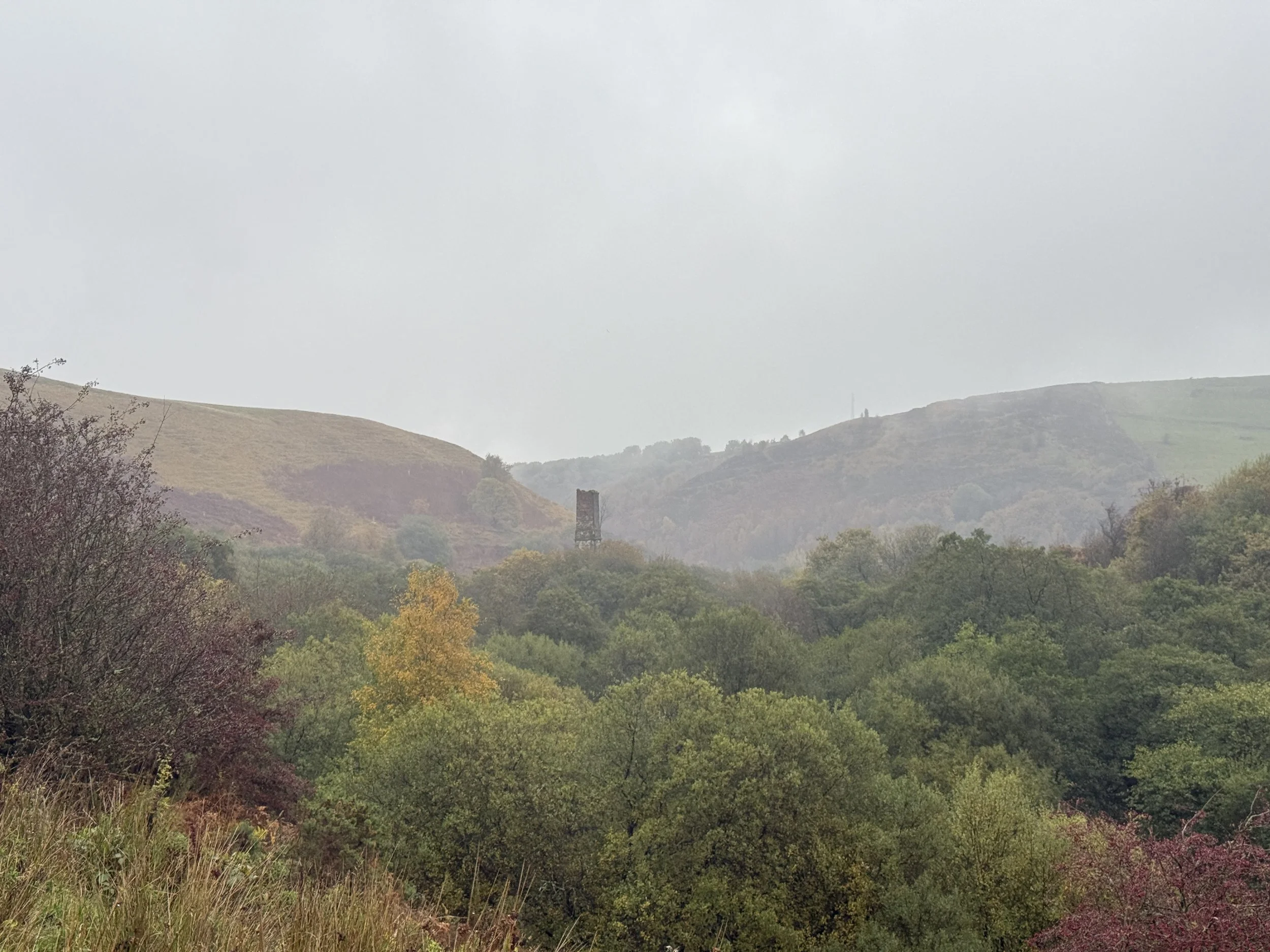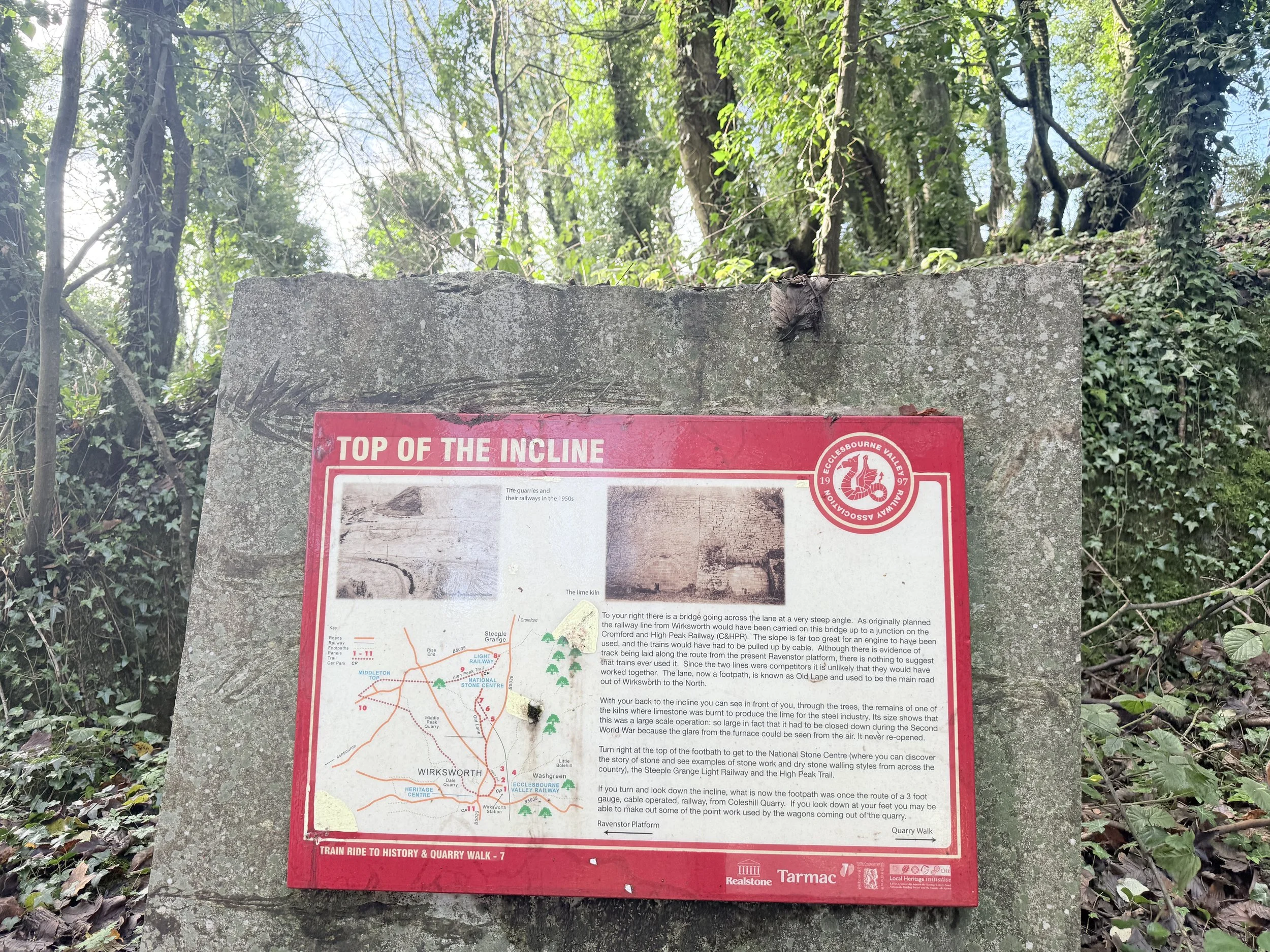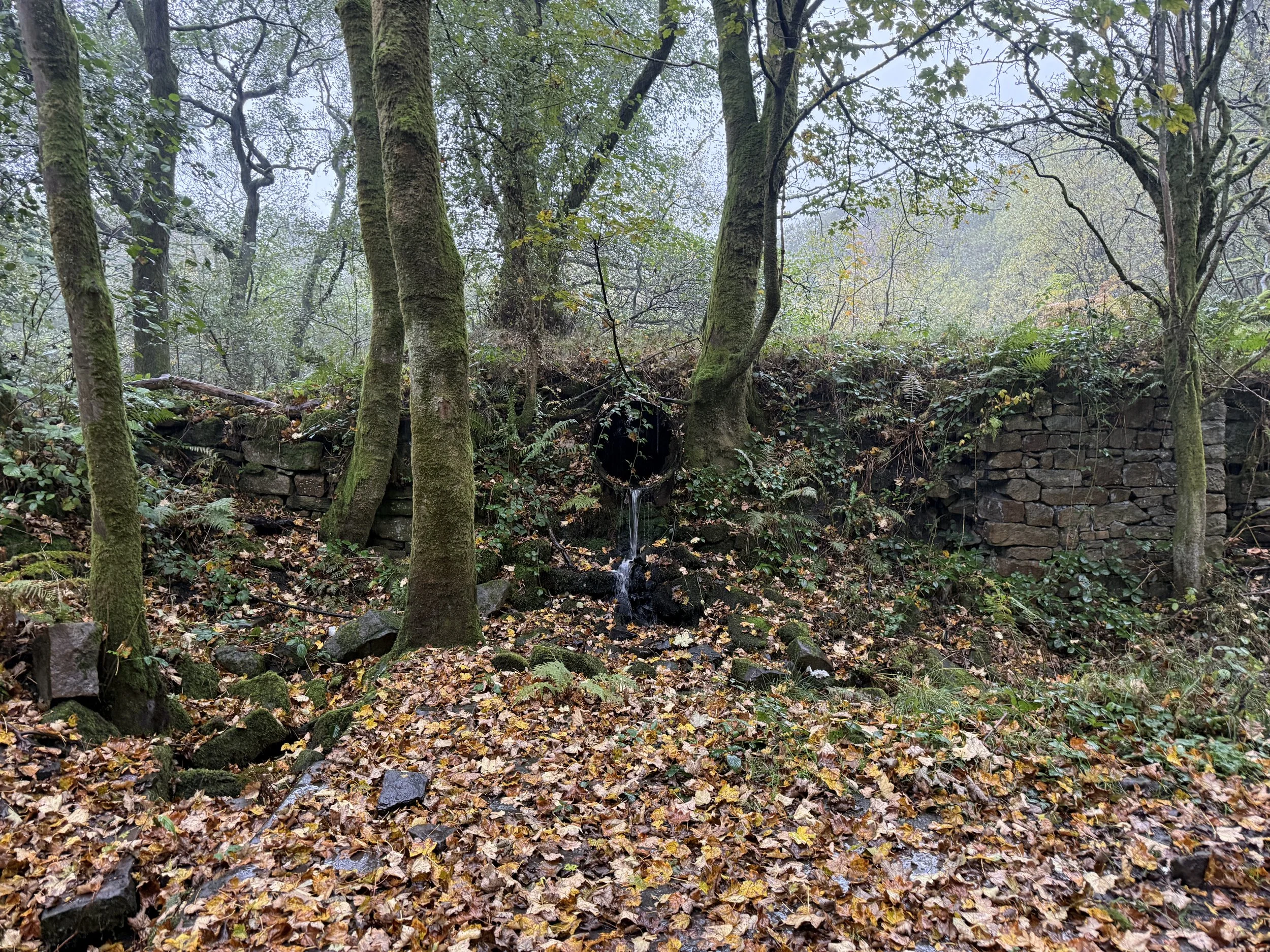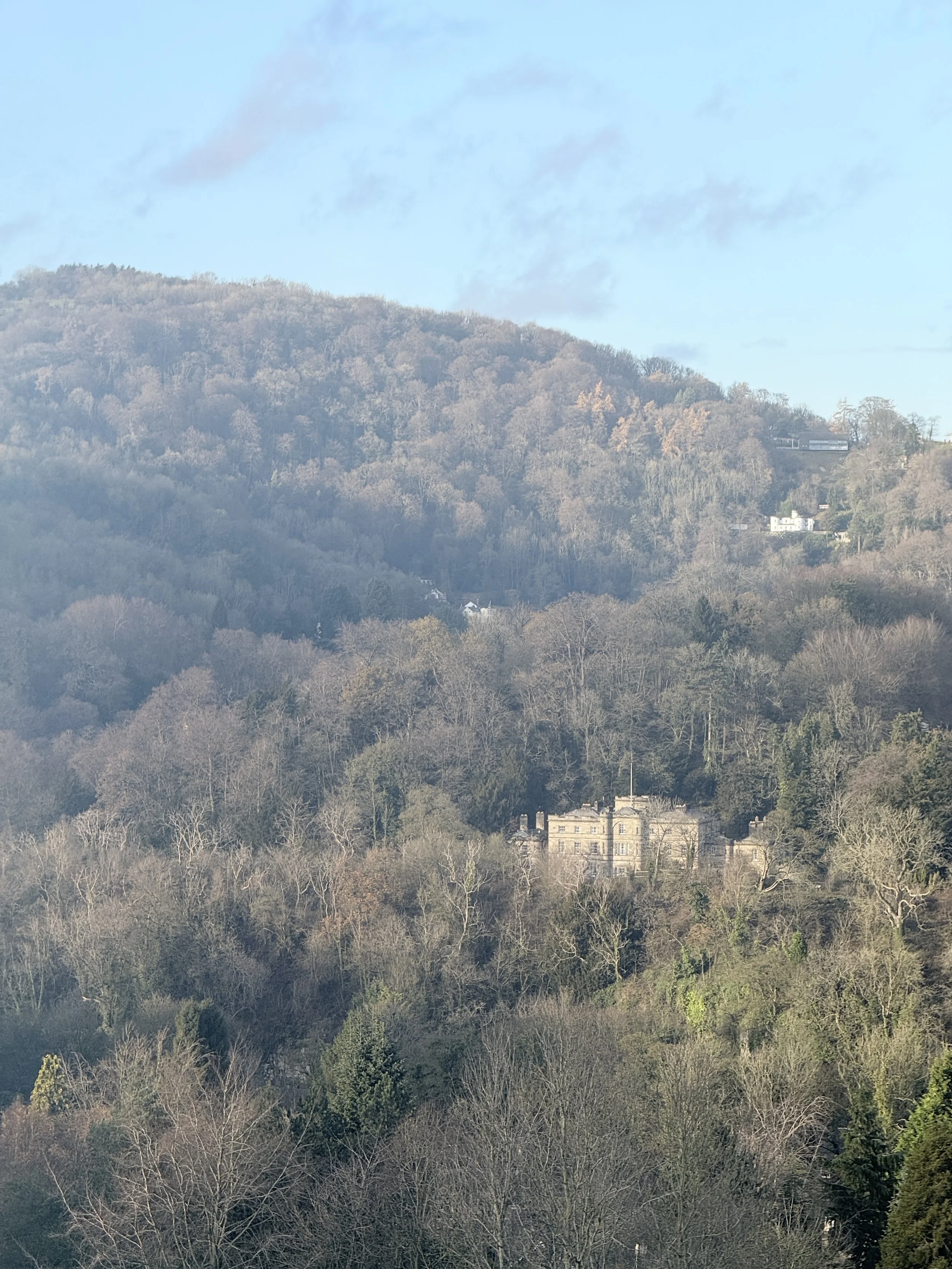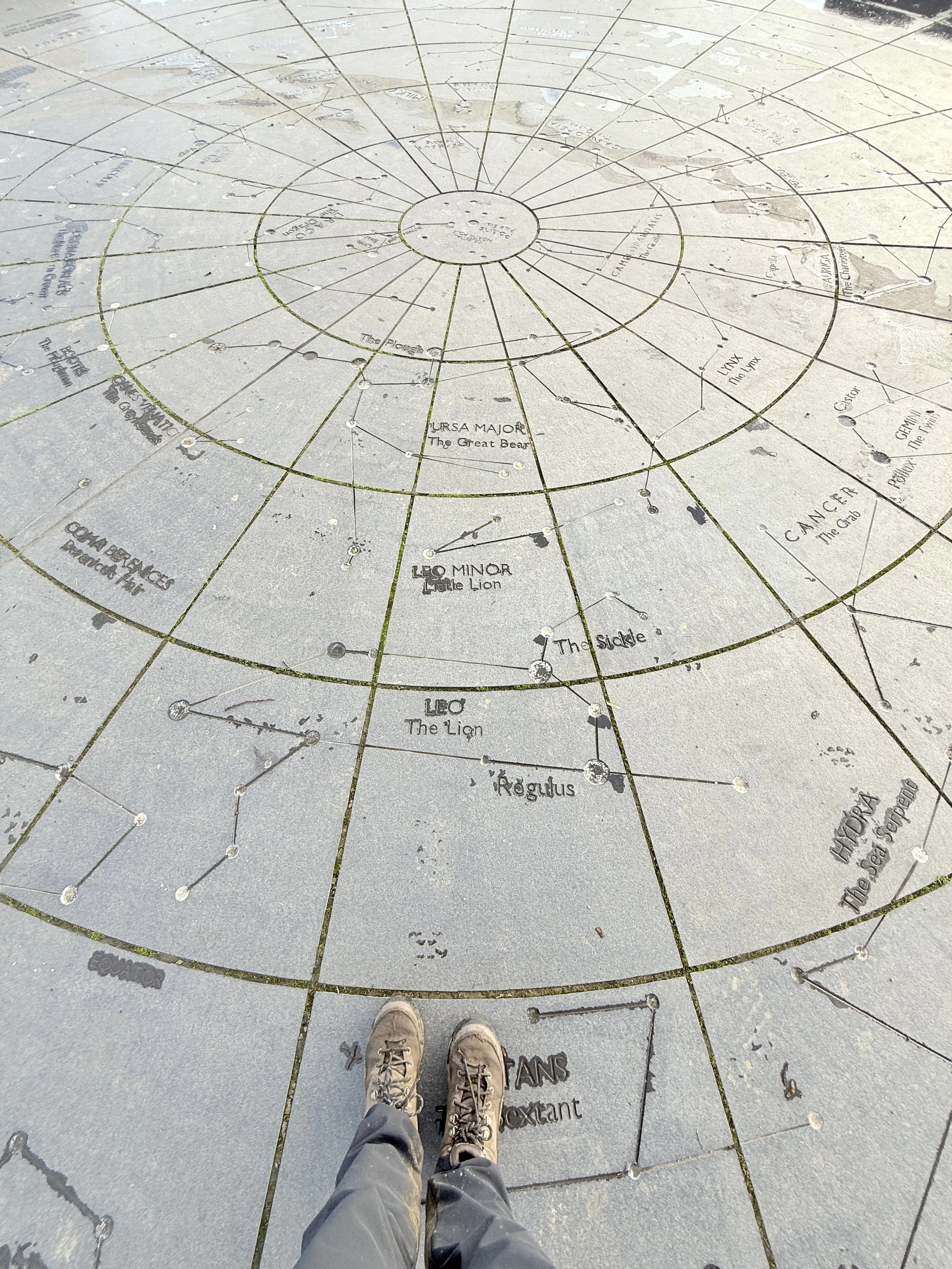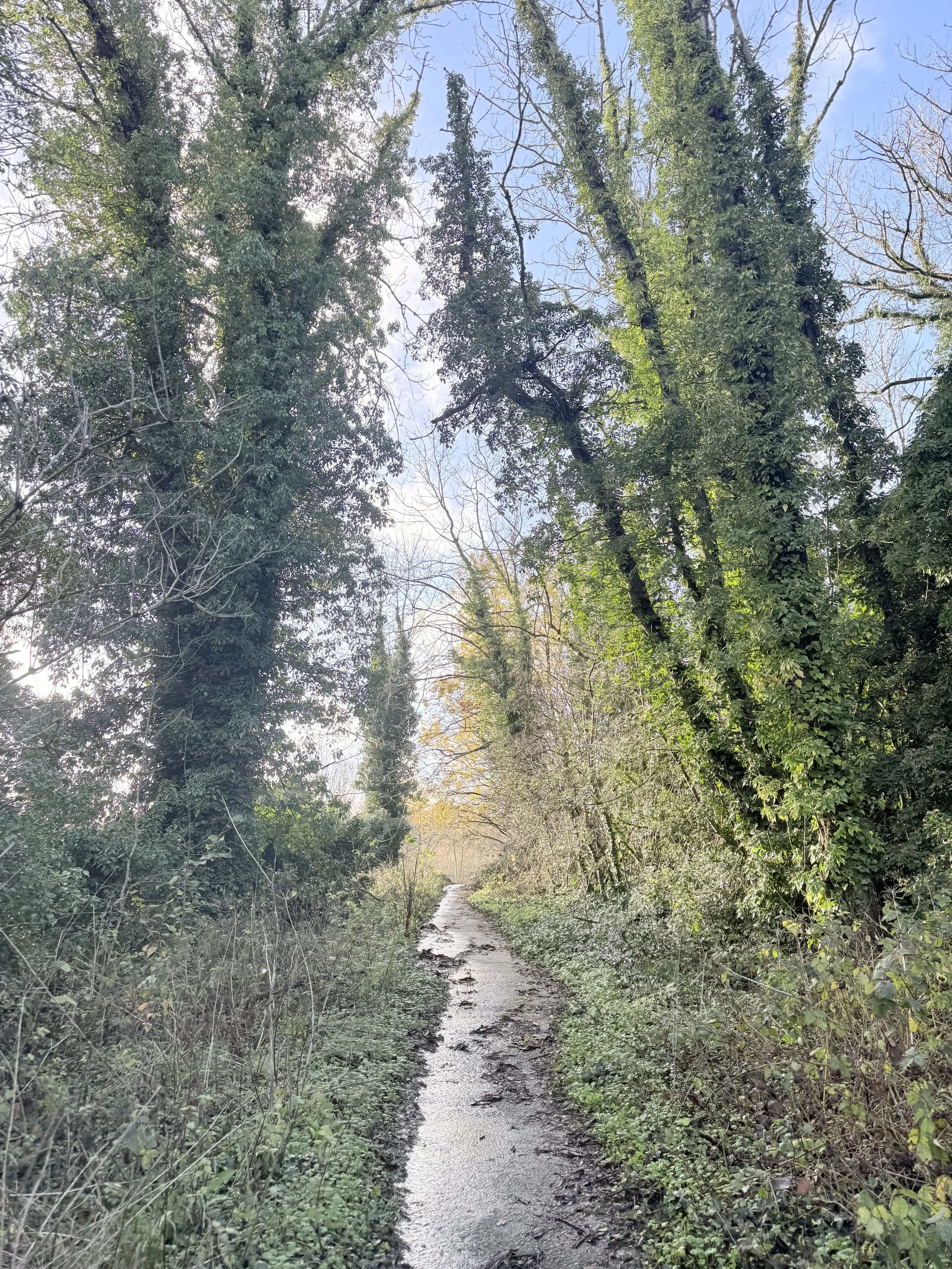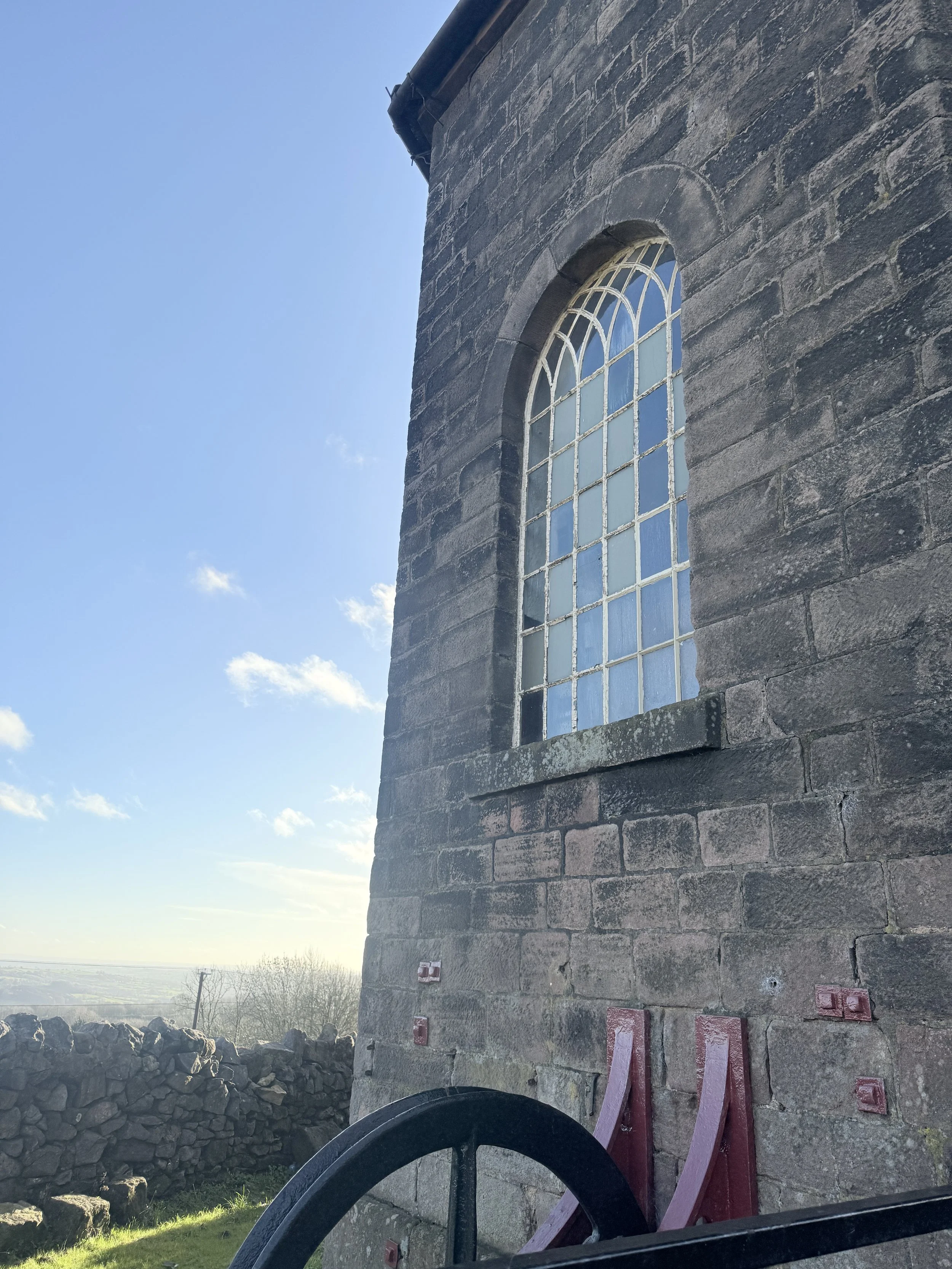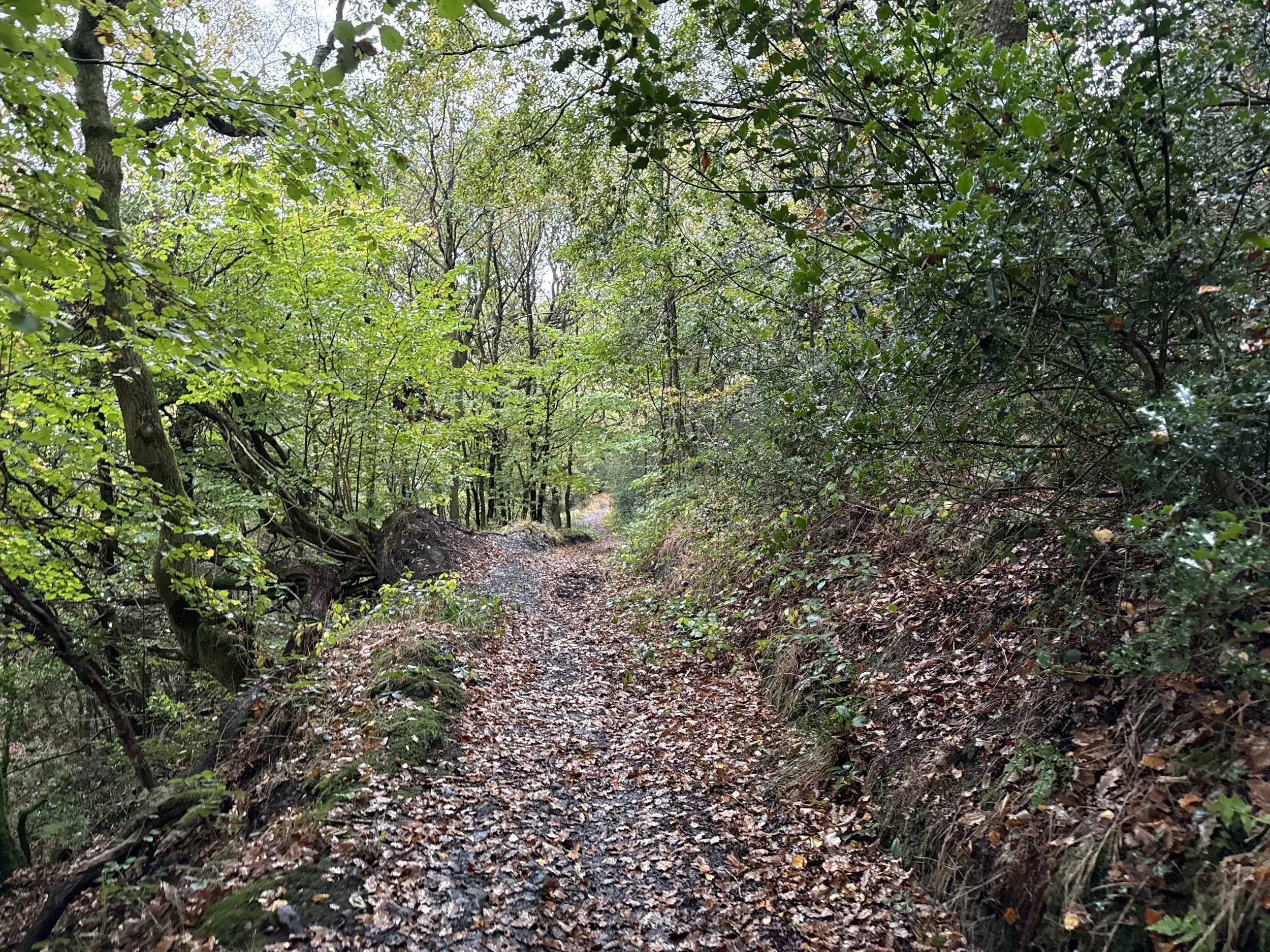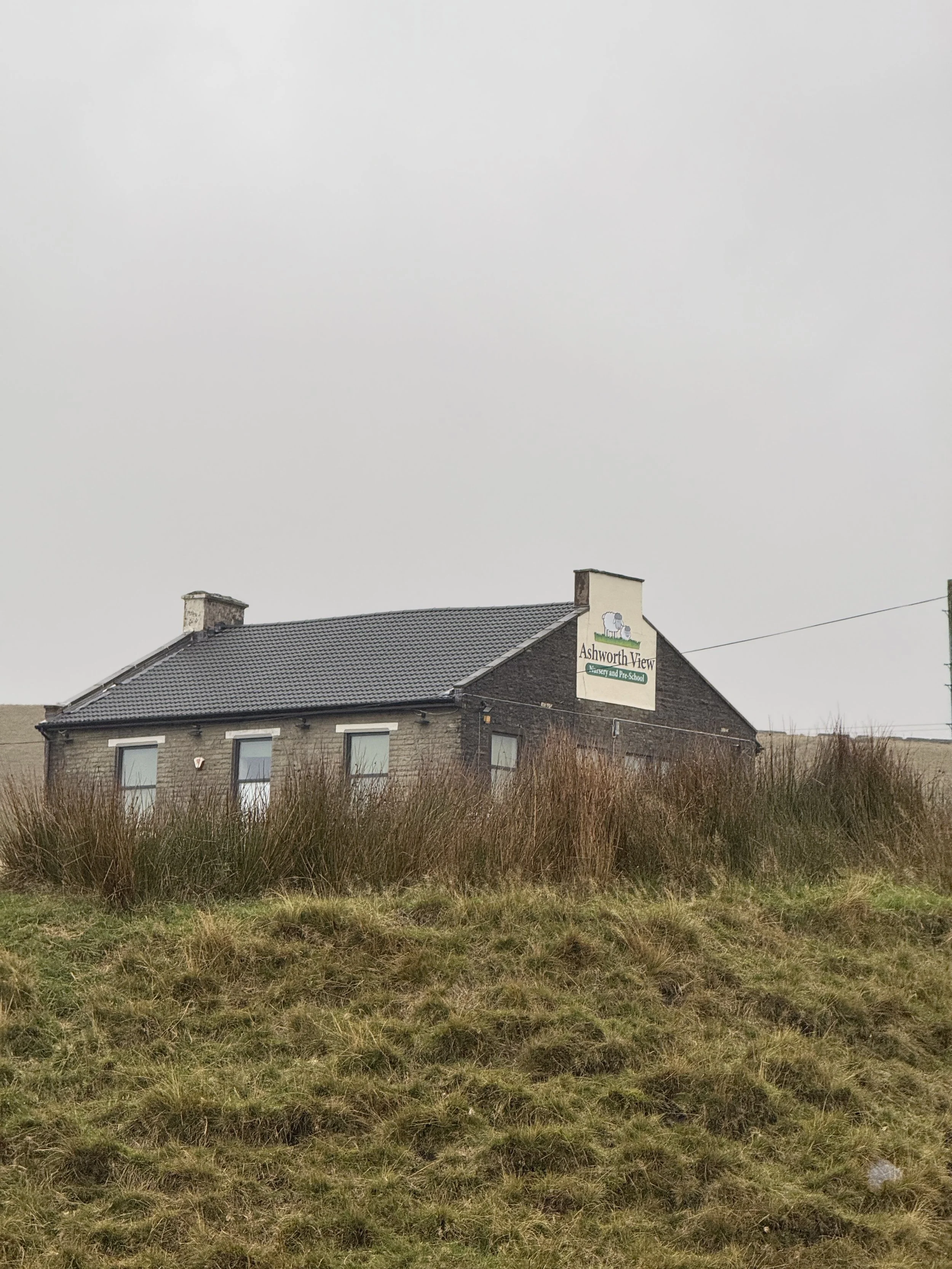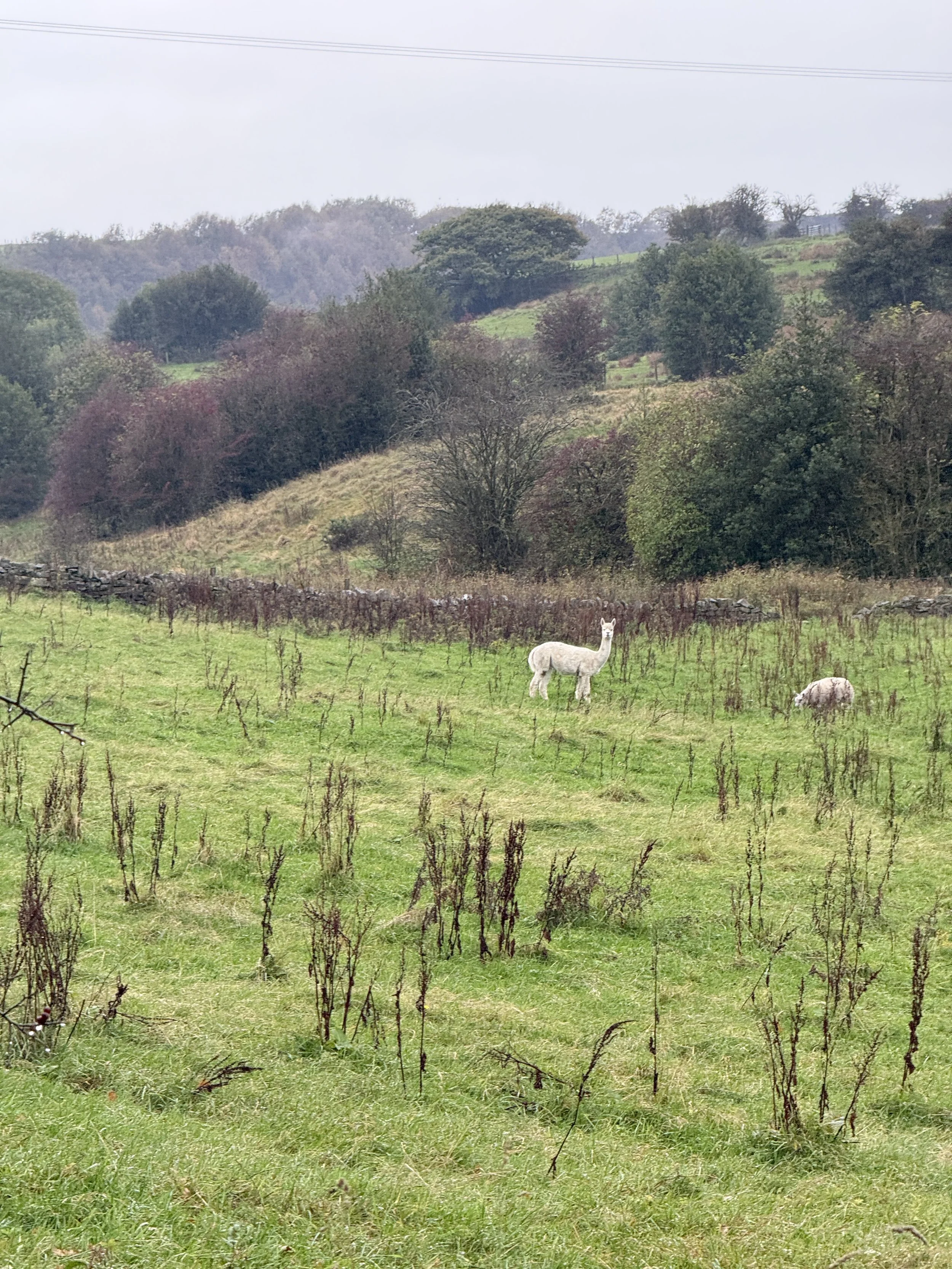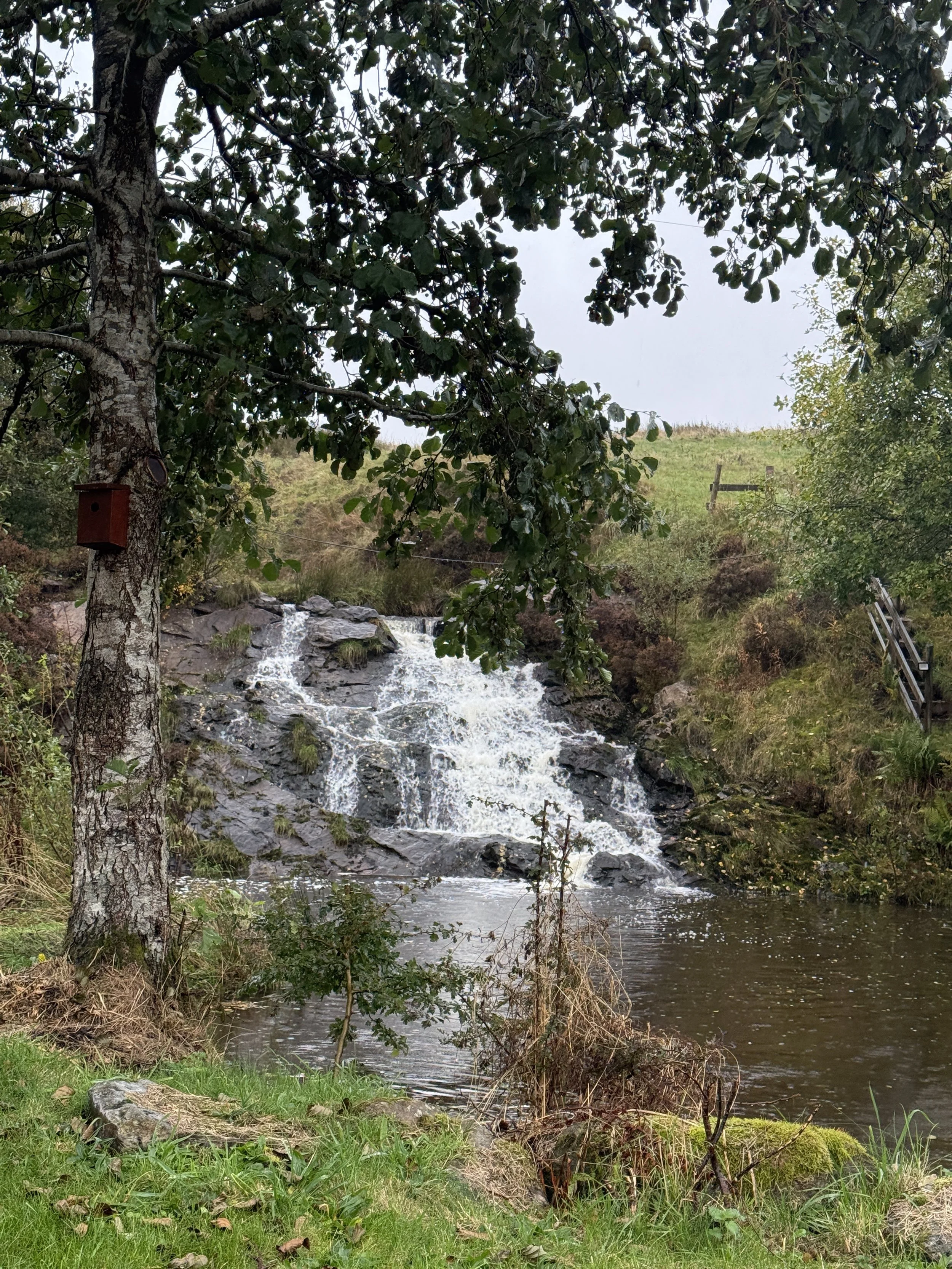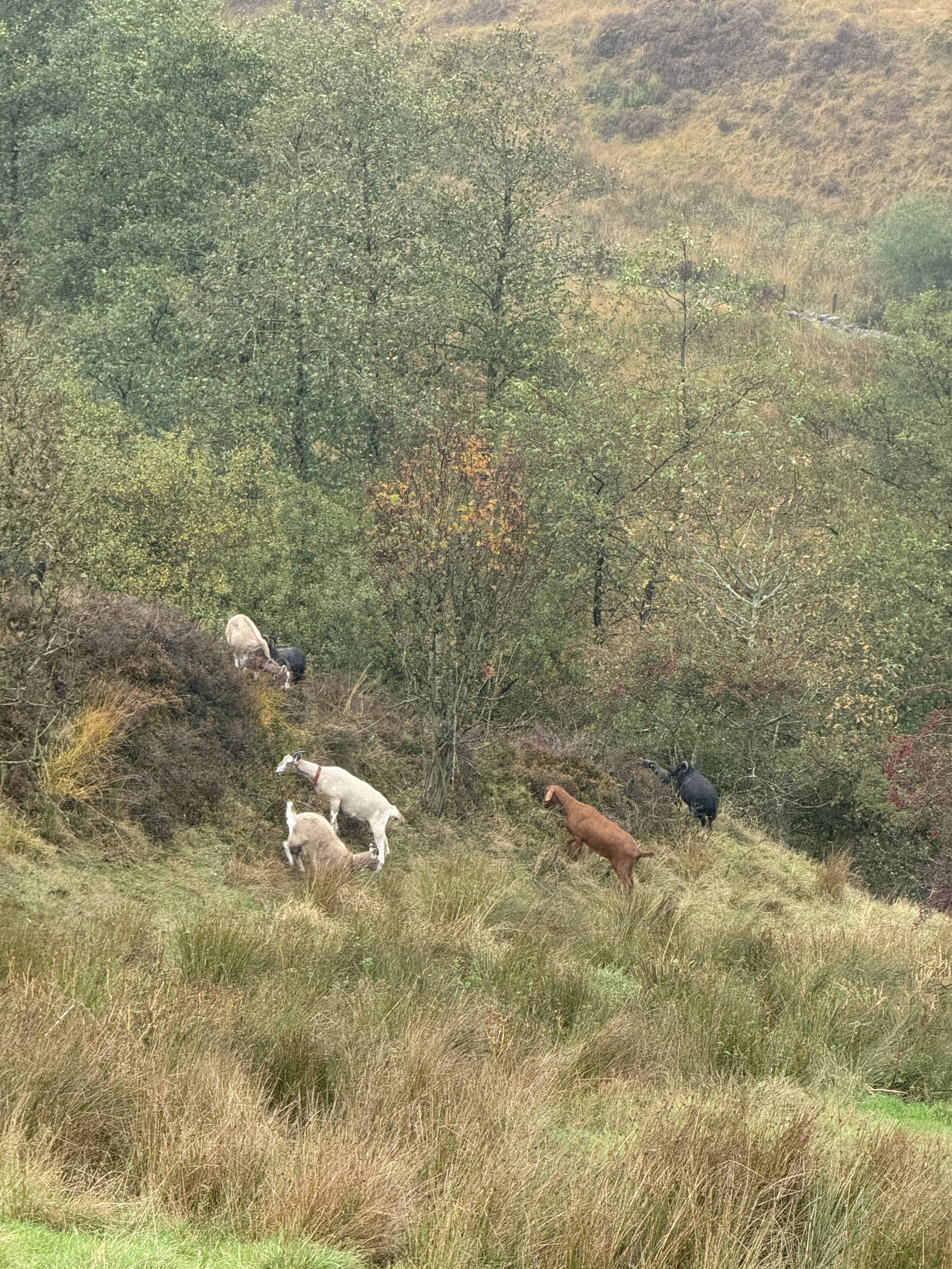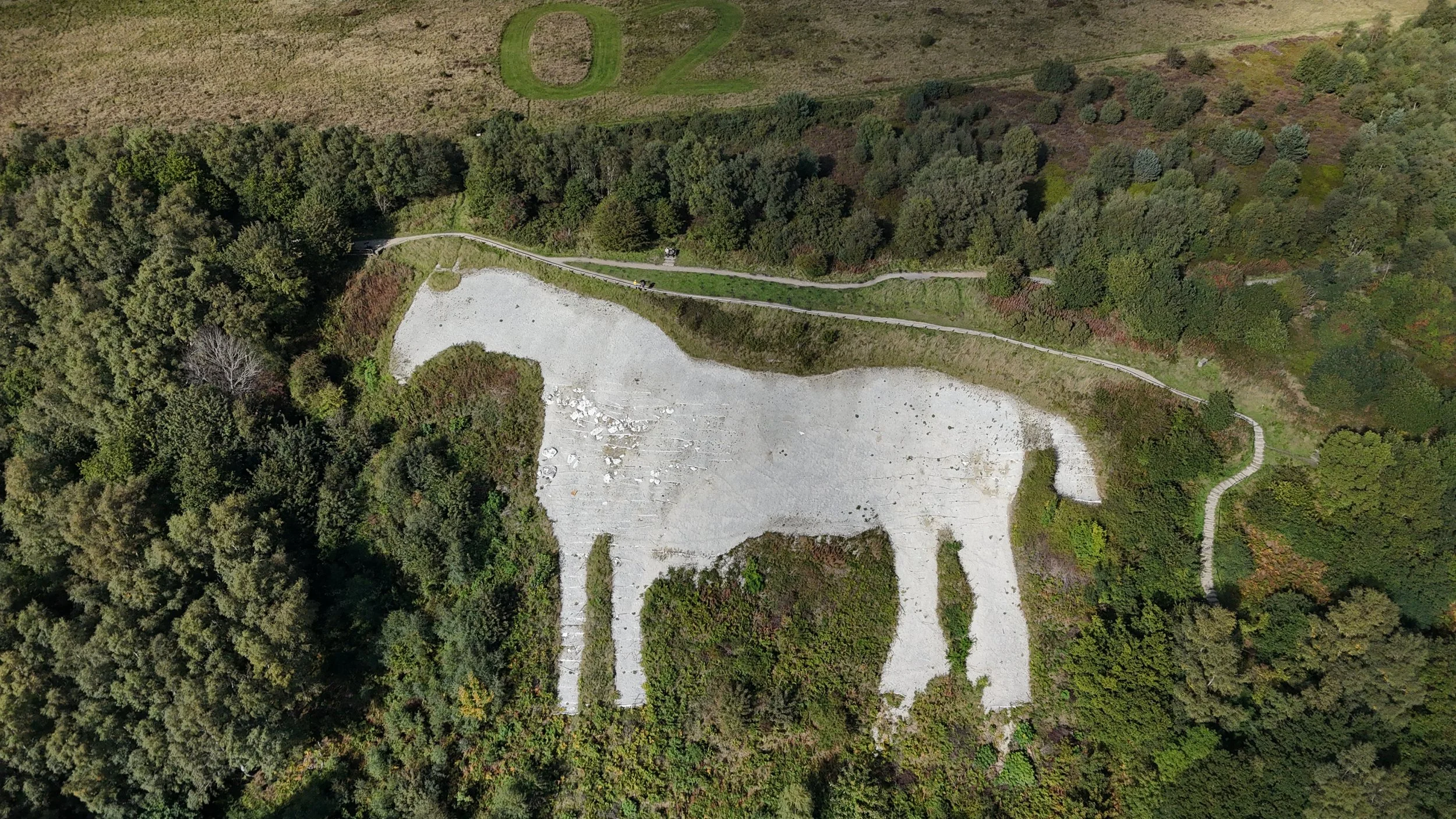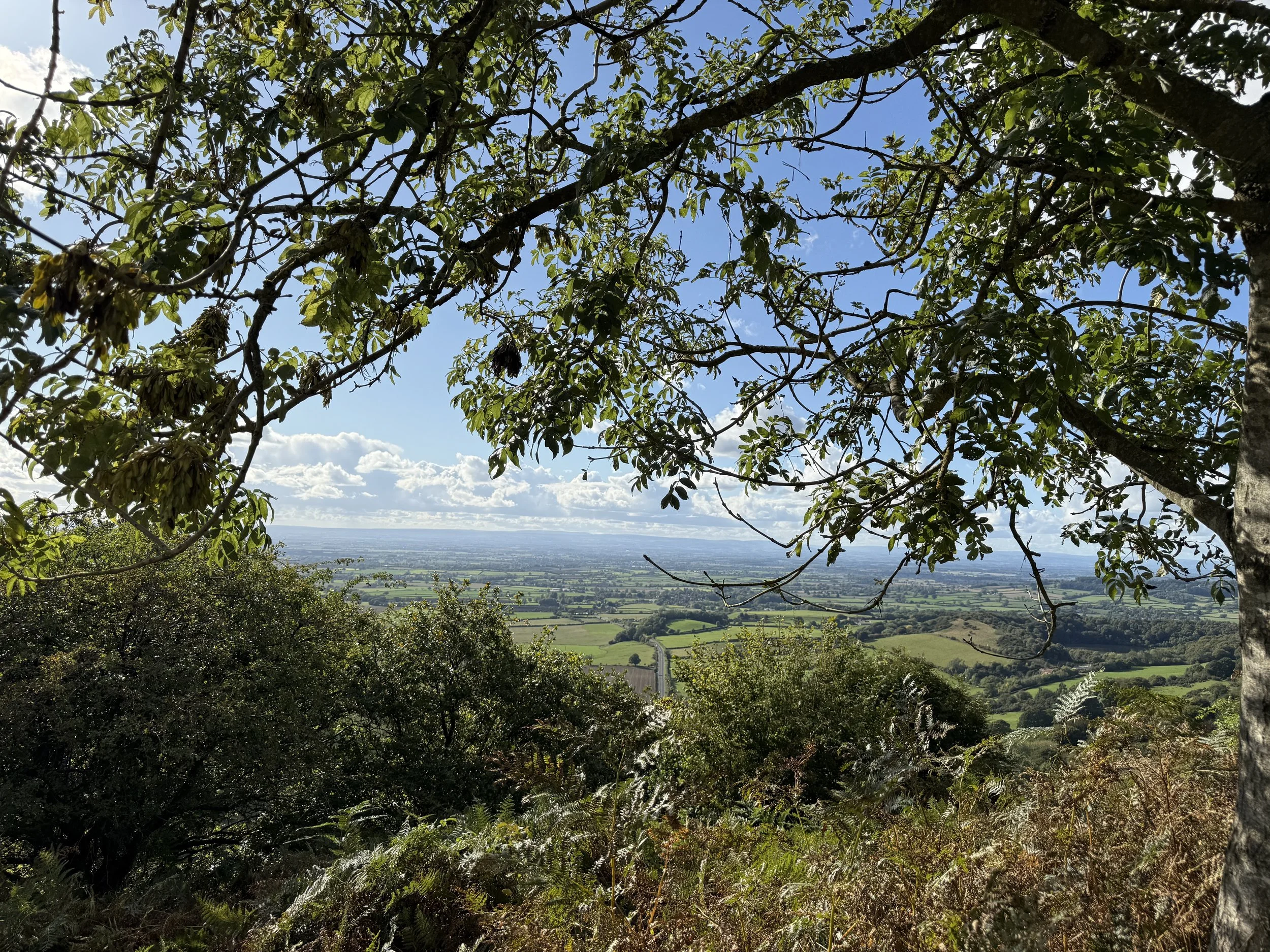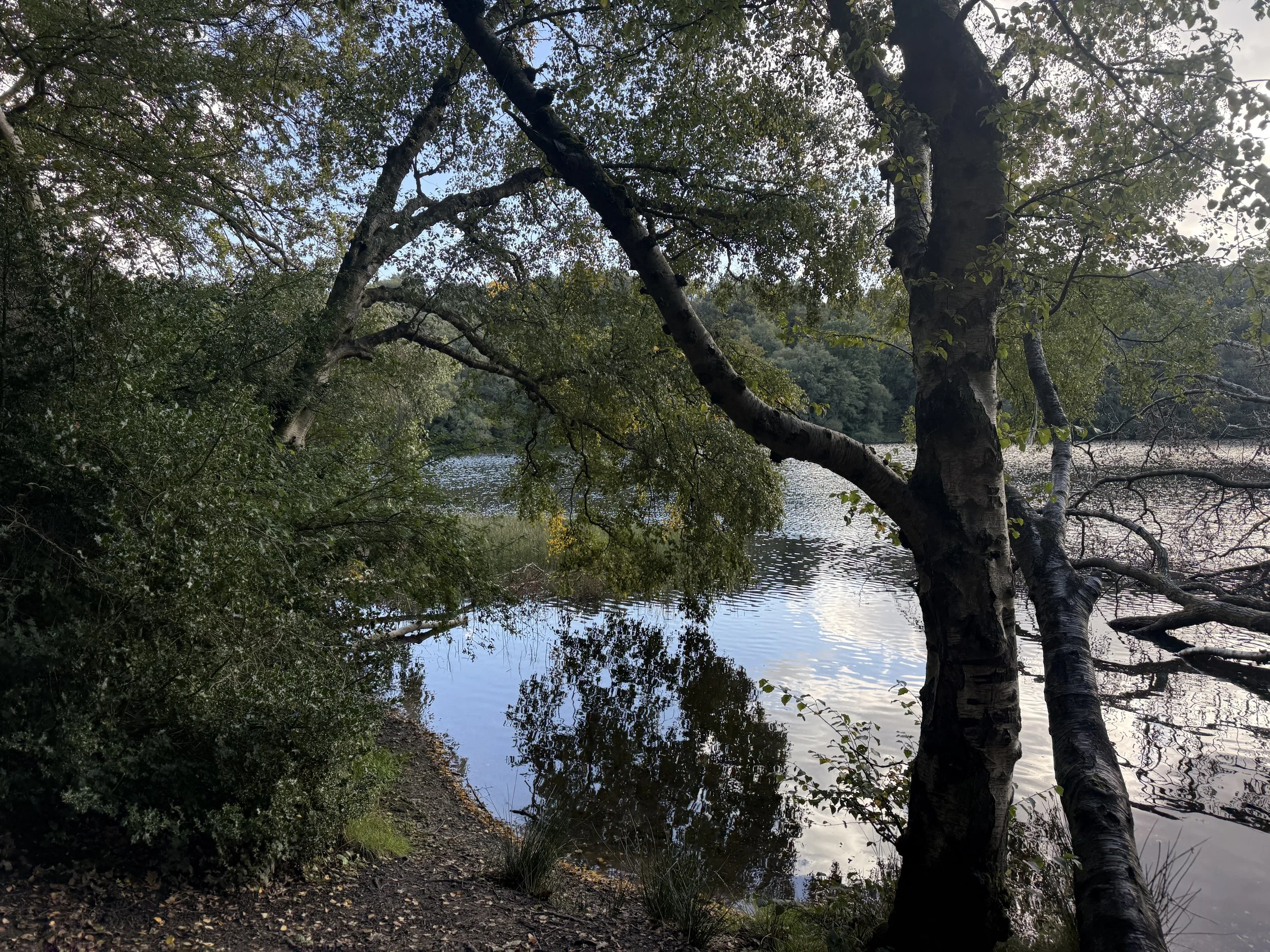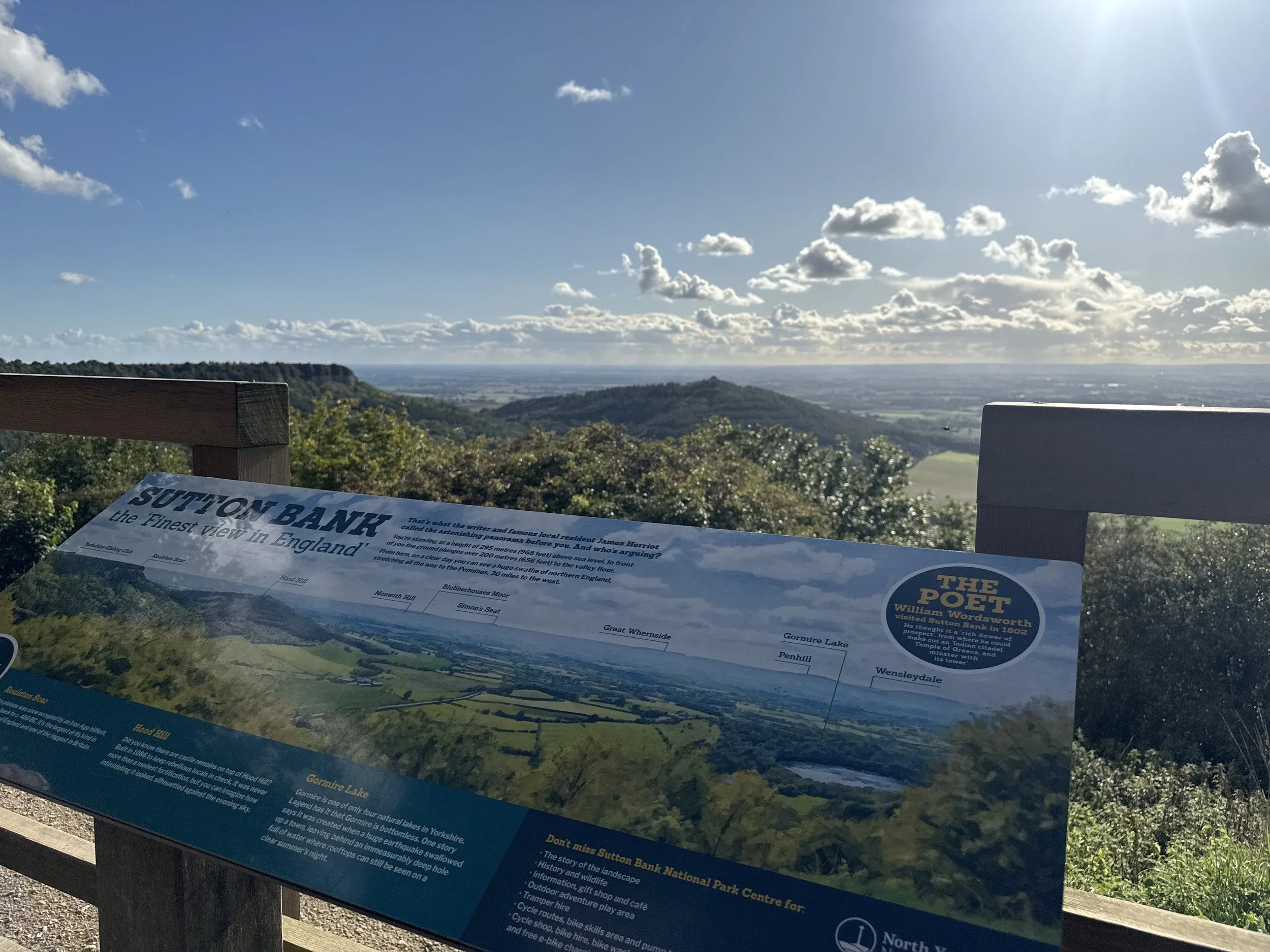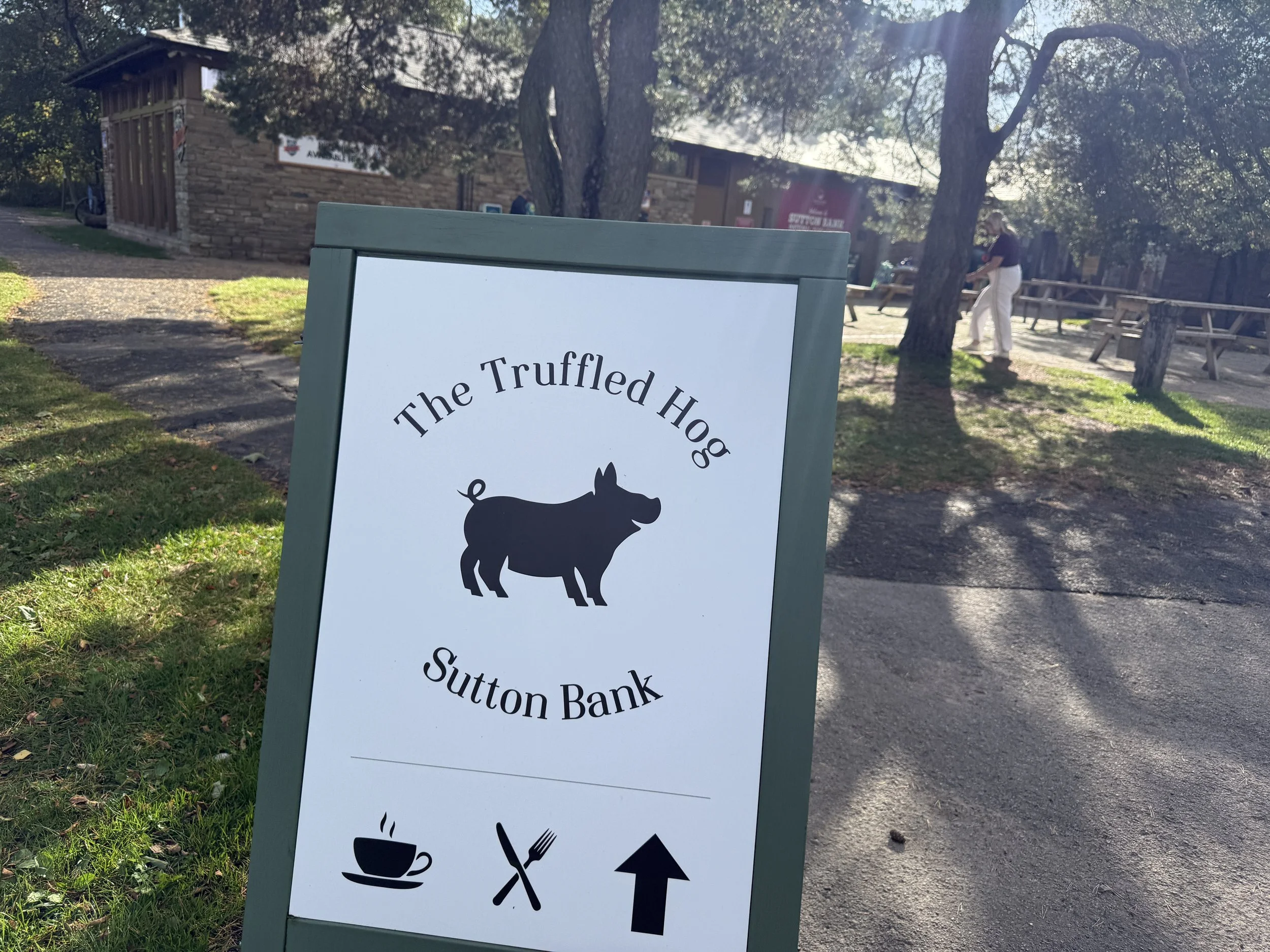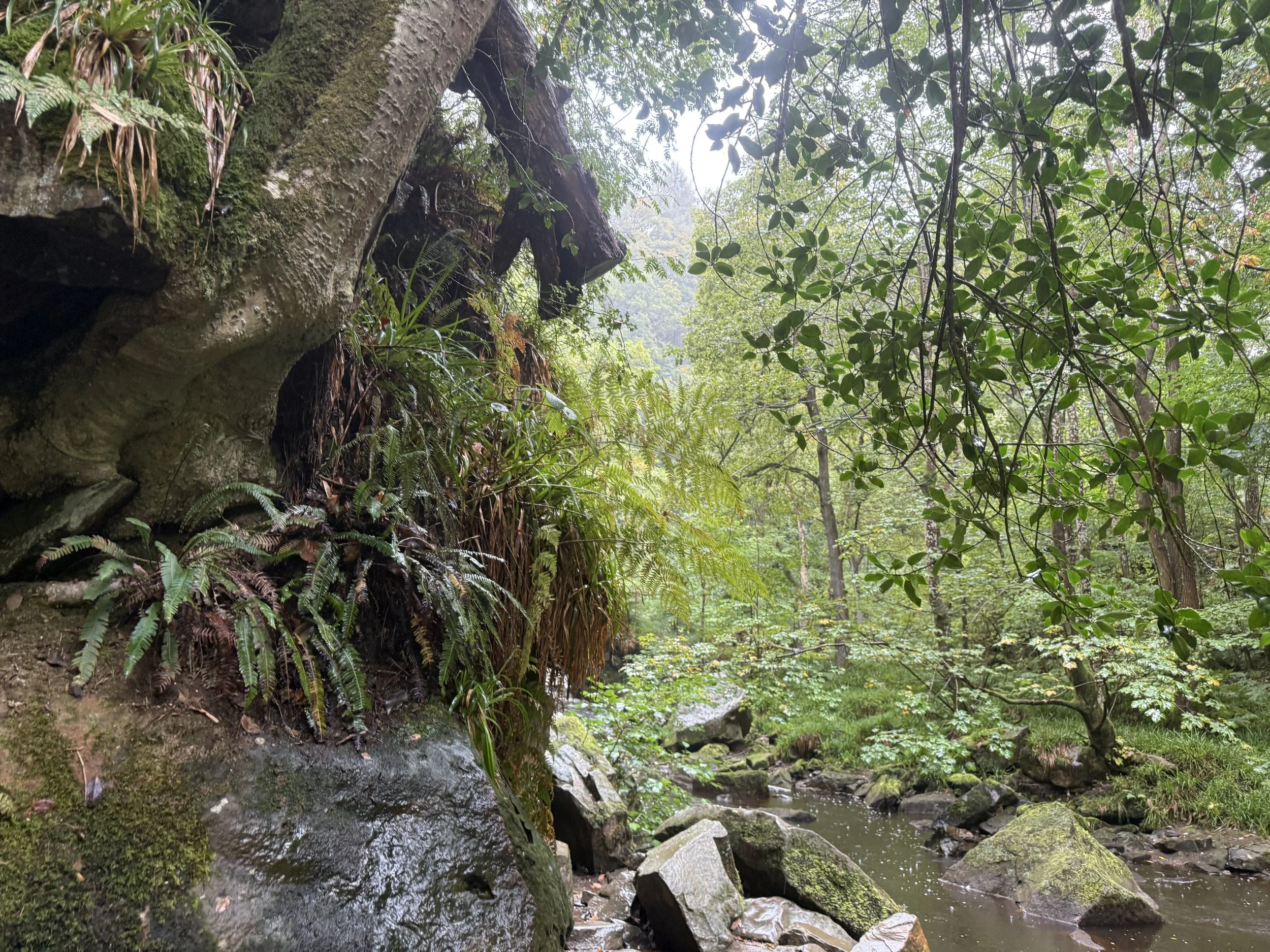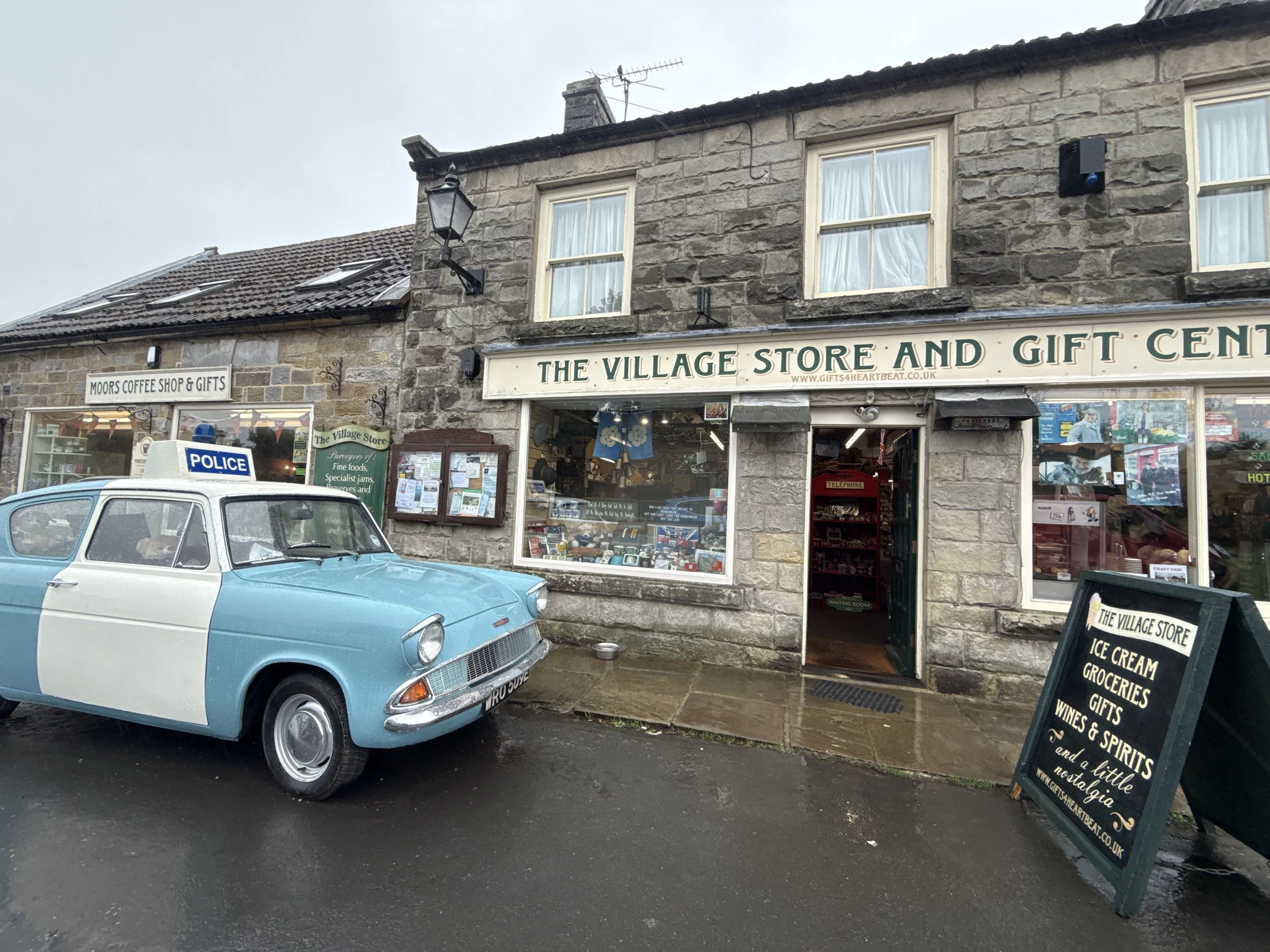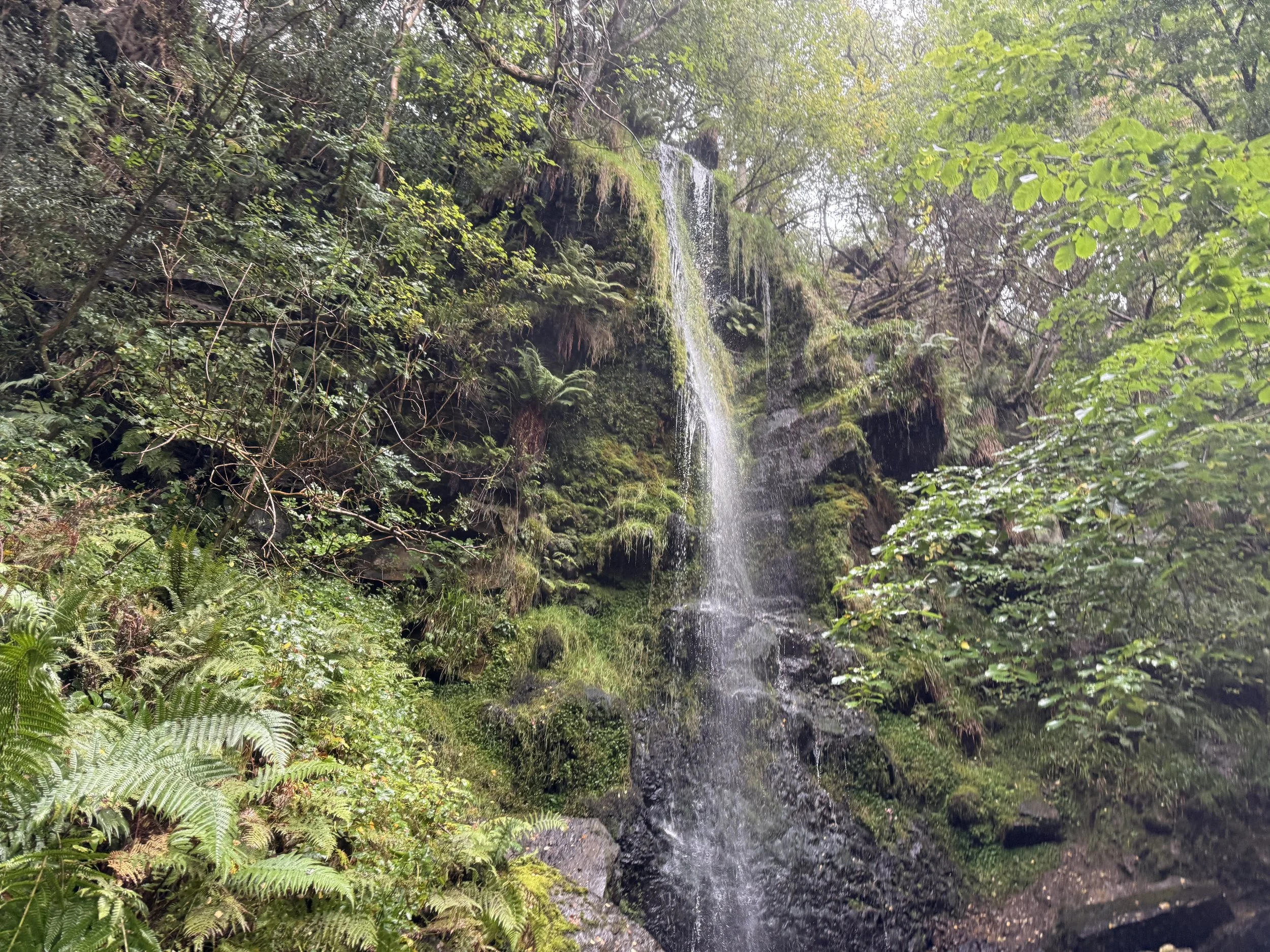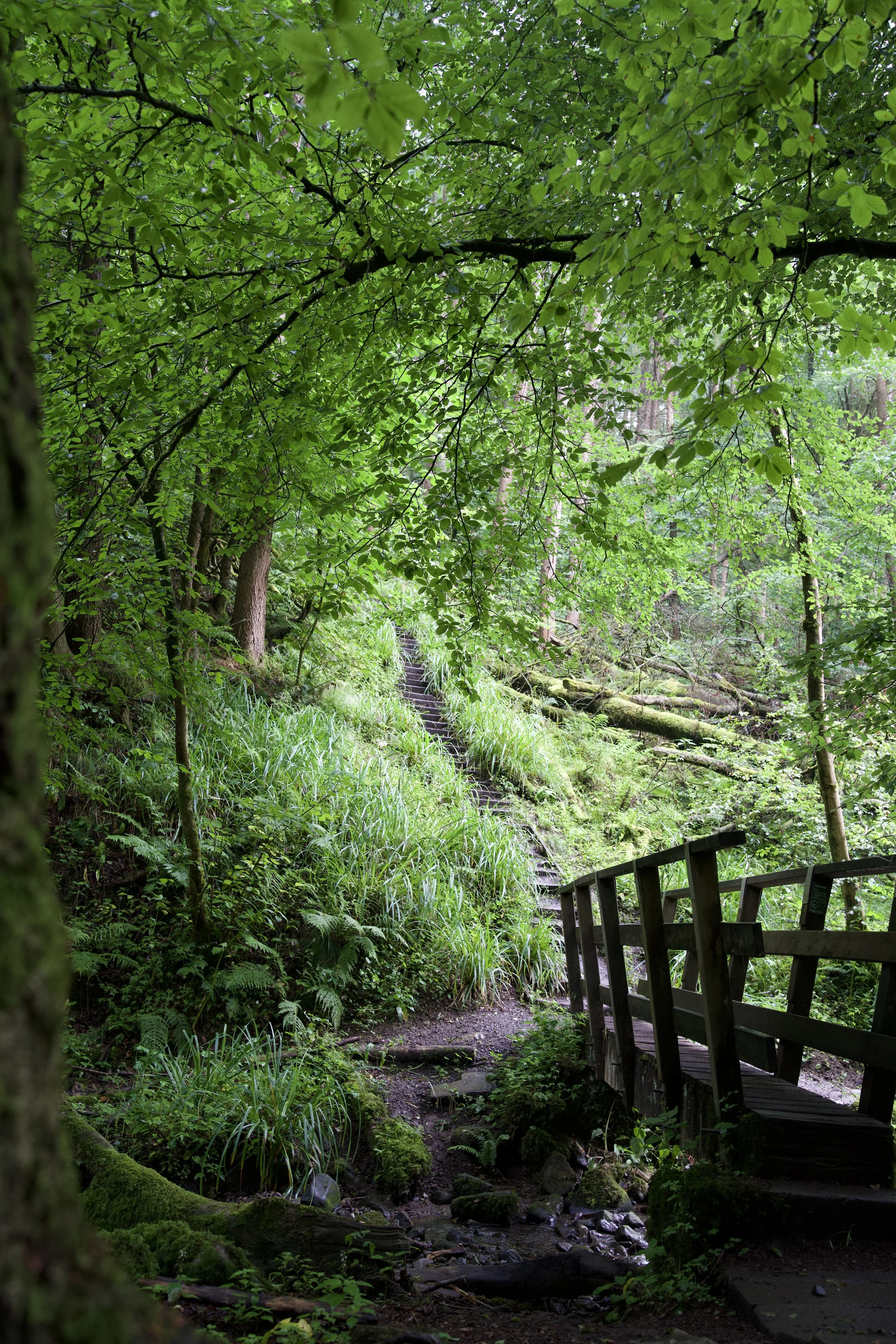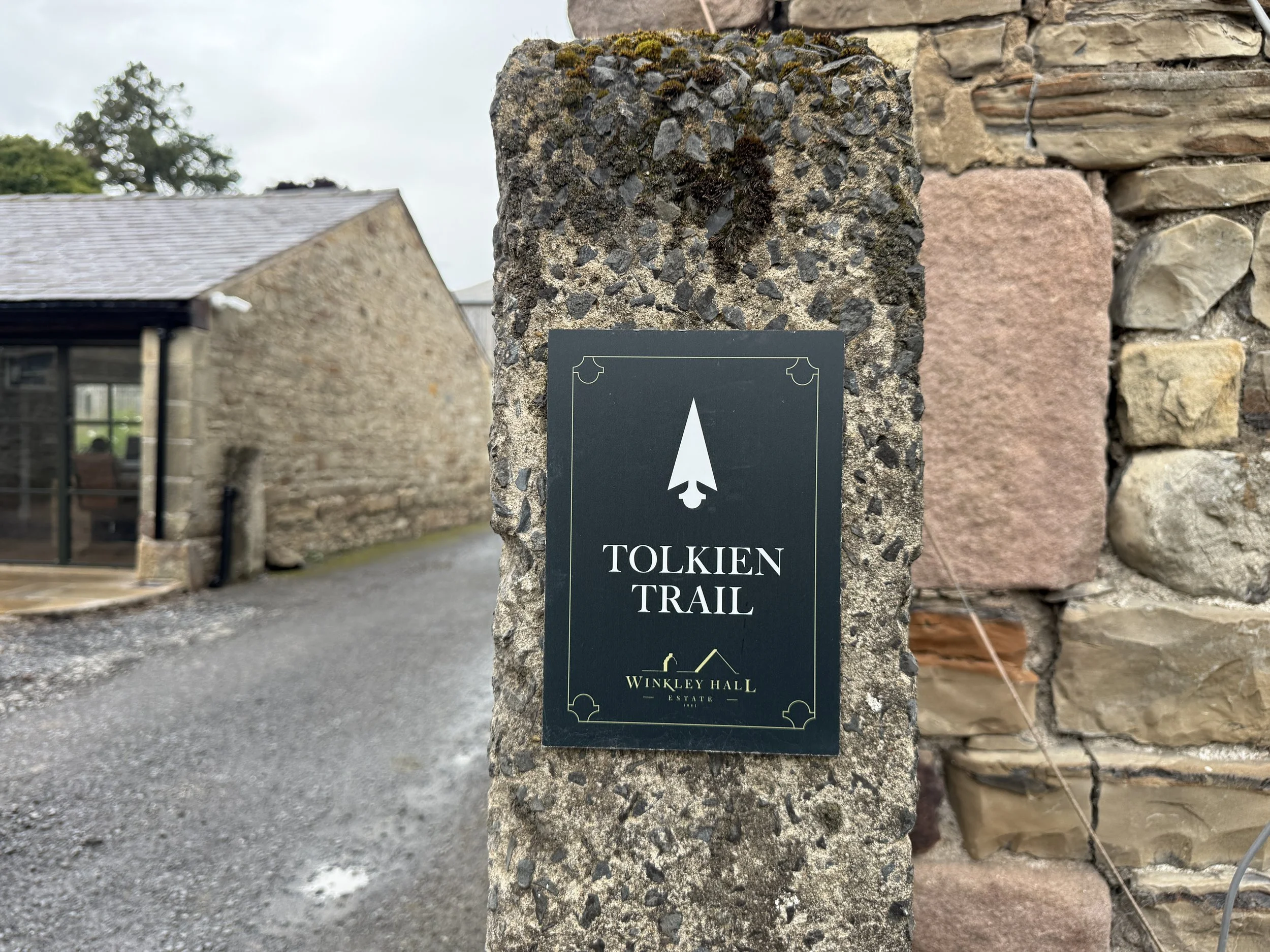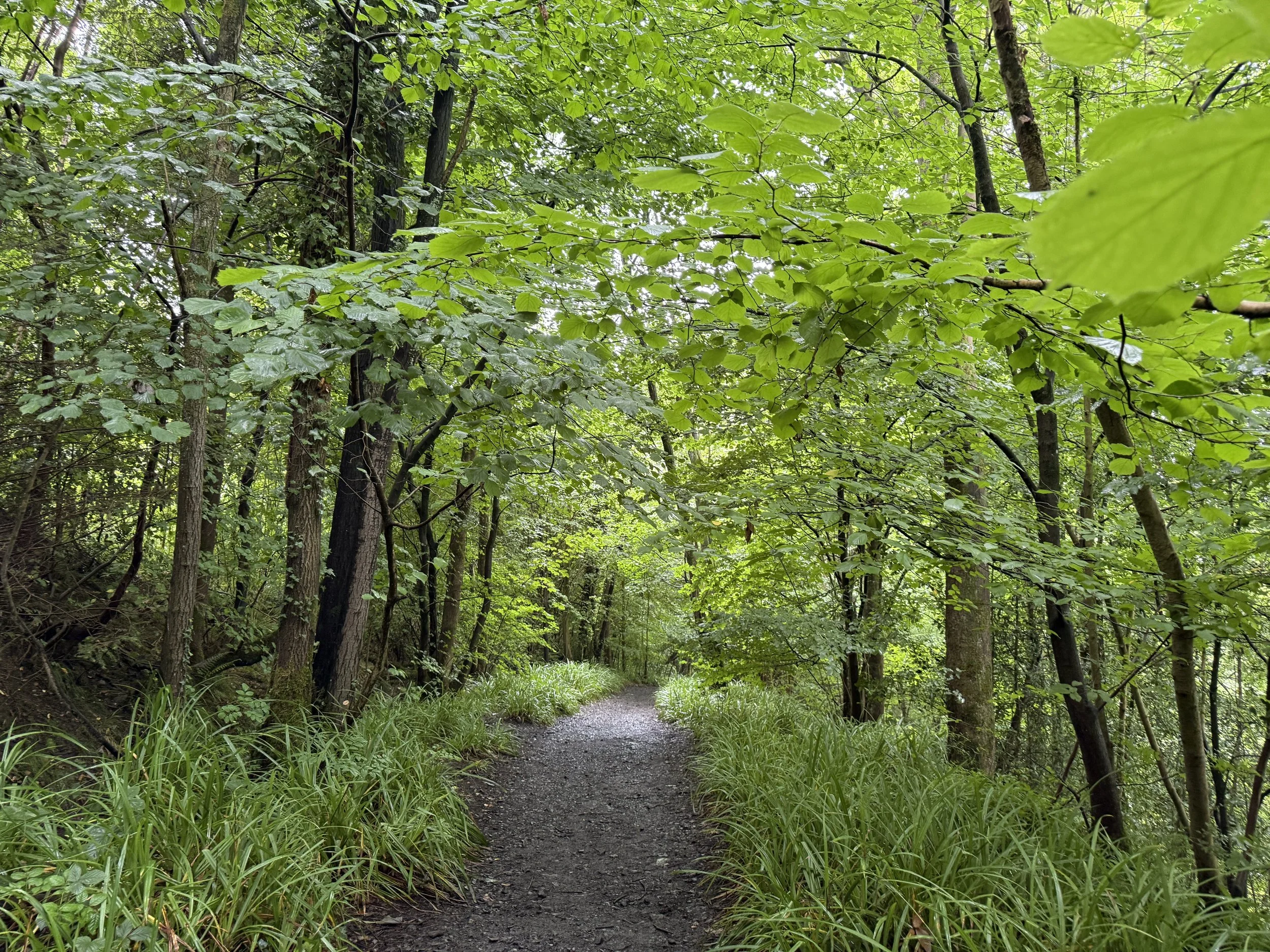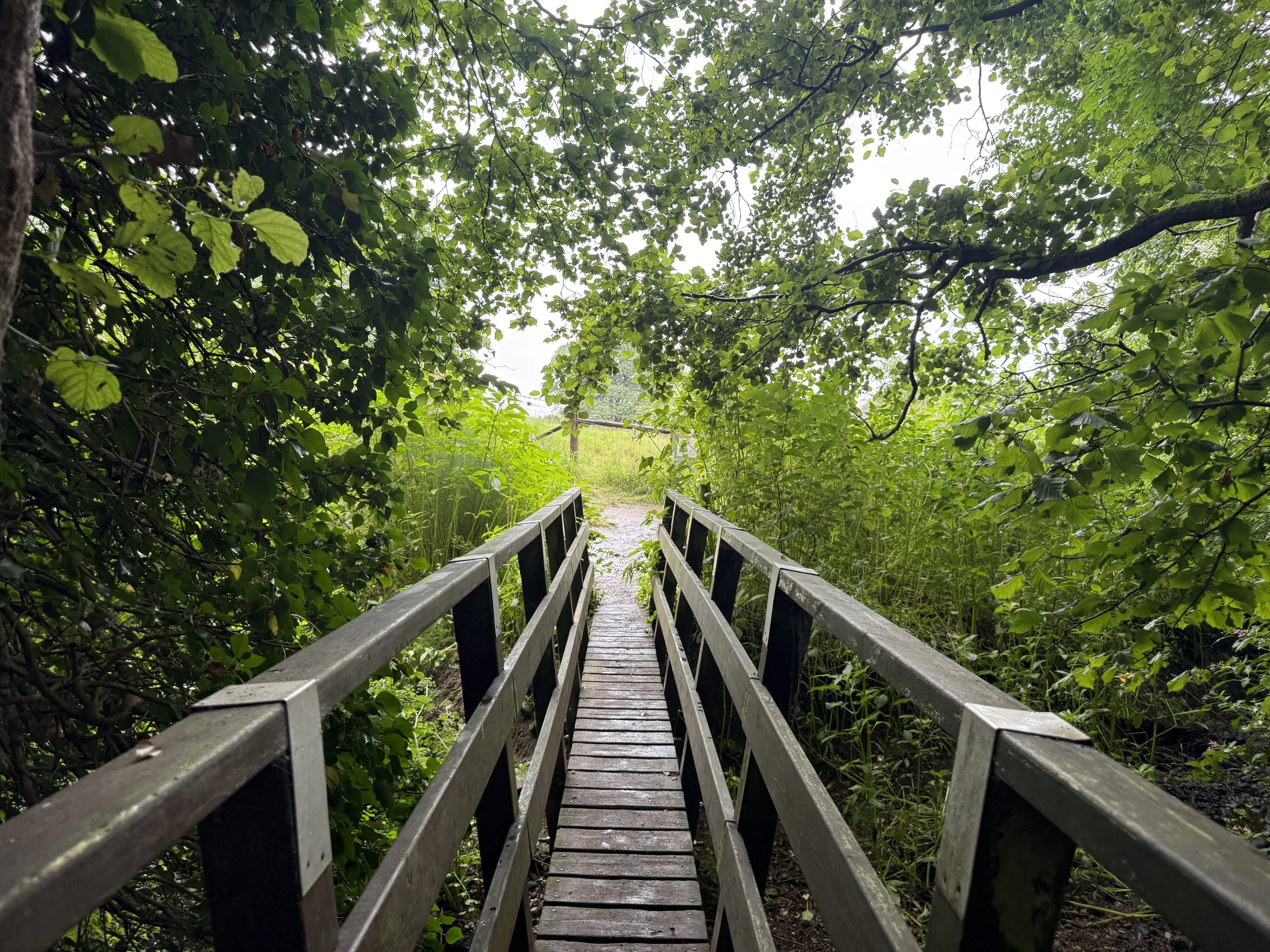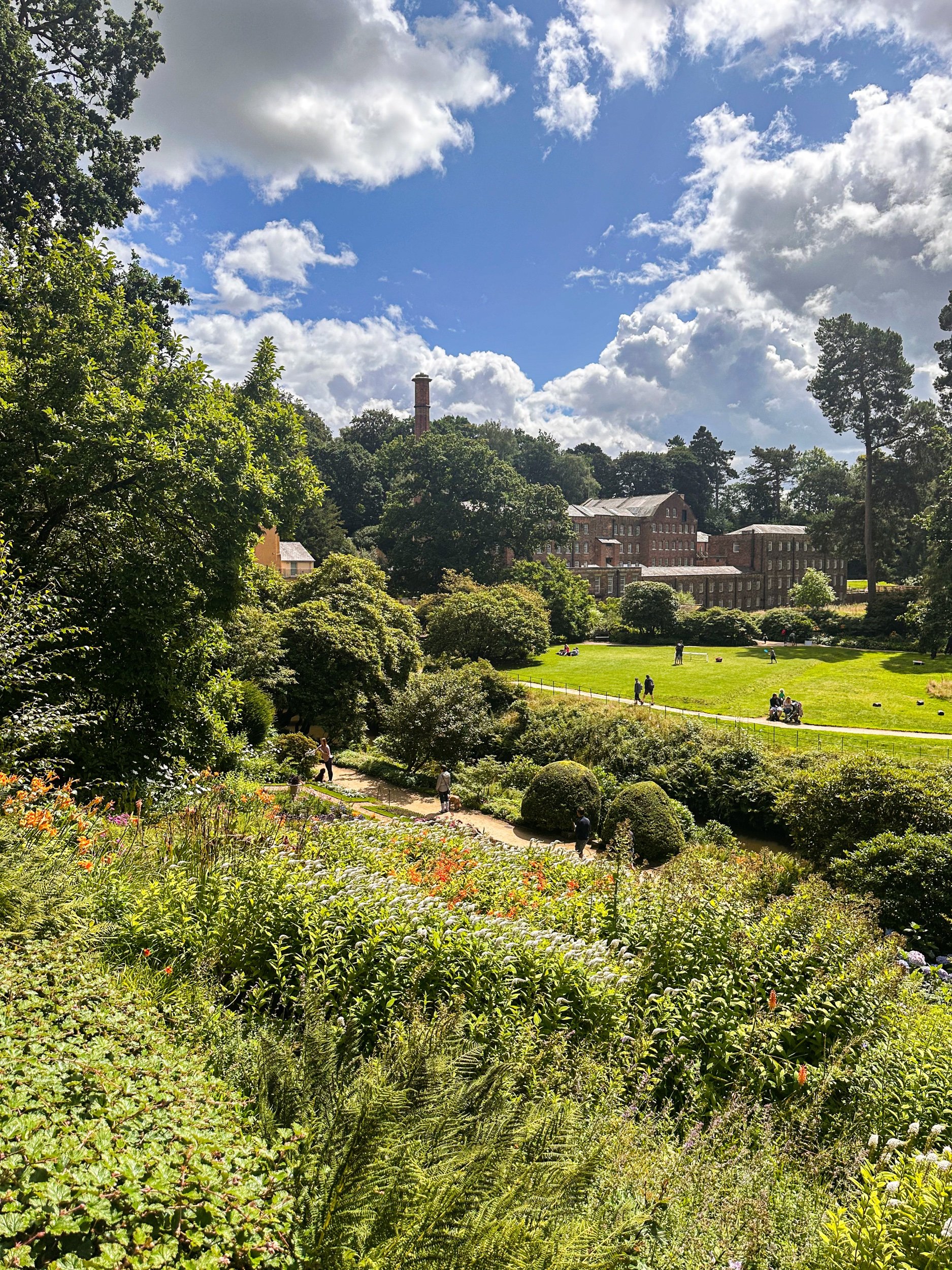ALL TRAILS
A Peak District Winter Walk: A traffic-free trail through Derbyshire's industrial past
This 8-mile circular starts at Cromford Station, looping along canal towpaths, railway trails and quarry edges (with lots of cafe stops along the way)
Start: Cromford Station, Derbyshire Dales
Distance: 8.92 miles
Elevation: 1,225 feet
Duration: 4 hours
Difficulty: Easy (with some steep sections)
Navigation: Follow step-by-step on komoot or download GPX file
About the route
This circular walk sets off from Cromford Station and takes you on a loop through one of the most historically rich corners of the Peak District. You'll pass the world-famous Cromford Mill, stroll beside a peaceful canal to High Peak Junction, climb the old railway incline to meet the High Peak Trail, detour up to a trig point, then loop around Black Rocks, the National Stone Centre, and Stoney Wood's glowing StarDisc before heading back to Cromford.
Expect a blend of stunning scenery, industrial relics and panoramic Peak District views, all without straying too far from a good brew or a pub stop.
Route difficulty
This is a mostly easy-going walk with a couple of short, steep sections — namely the Sheep Pasture Incline and the climb to Bolehill trig. Most of the route follows well-surfaced paths, including the flat canal towpath and the former railway line. There aren’t any technical sections on this walk: the paths are easy to follow. Some sections are suitable for prams, but the trig point and Black Rocks should be avoided if you're wheeling it.
Walk type: Circular
Start/finish: Cromford Station, DE4 3QJ
Terrain: Canal towpath, old railway trail, woodland, moorland edge
Difficulty: Easy–moderate with short steep sections
Good for: Heritage lovers, car-free adventures, varied scenery
Facilities: Toilets, cafes, pubs, bookshops at Cromford Mill and High Peak Junction
Route highlights
Cromford Mill
The world's first successful water-powered cotton mill, built in 1771 by Sir Richard Arkwright. Now home to cafes, bookshops, heritage tours and at Christmas — fairy lights and festive trees.
Cromford Canal
Flat, tranquil and stunning in the colder months. Look out for the Leawood Pump House and other historic canal architecture as you wander toward High Peak Junction.
High Peak Junction
Where canal meets railway — once a key interchange in Derbyshire’s industrial heyday. Pop into the heritage visitor hut if it’s open.
Sheep Pasture Incline
A short, sharp climb that once hauled goods up to the High Peak Railway. These days it hauls your legs up to great views.
Molehill Trig (unofficial name)
A brief detour off the main trail, this trig point rewards you with moorland views across Matlock.
Black Rocks
Dramatic gritstone outcrops popular with climbers. Scramble up for wide views over Cromford and Matlock Bath.
National Stone Centre
Pause to learn about the geology under your boots — or just enjoy the weirdly satisfying rock formations and sculpture trail.
StarDisc, Stoney Wood
Set within a reclaimed quarry above Wirksworth, the StarDisc is a 12-metre granite star chart representing the Northern Hemisphere night sky. It’s surrounded by 12 stone seats — one for each month — and serves as both a public artwork and celestial amphitheatre.
Middle Peak Quarry
A reminder of the area's quarrying past and present — part of the landscape’s working history.
Where is Cromford?
Cromford sits on the edge of the Peak District in Derbyshire’s Derwent Valley. It’s part of a UNESCO World Heritage Site thanks to its role in the Industrial Revolution and is well-connected by train, making it a brilliant base for car-free walks.
Things to do nearby
Visit Cromford Mill and take a guided heritage tour
Browse Scarthin Books — a legendary indie bookshop just over the canal
Ride the Heights of Abraham cable car in nearby Matlock Bath
Explore Lea Wood or Cromford Meadows for bonus easy loops
Pop into the pub or café after your walk — several options in Cromford village
Is this walk suitable for beginners?
Yes — especially if you're comfortable walking for a few hours with a bit of uphill effort. The paths are well-marked and easy to follow, but good footwear is recommended for the steeper/muddier sections. To make it easier, stick to the canal and High Peak Trail sections and skip the Black Rocks and trig point.
Is the route dog-friendly?
Yes! Dogs are welcome on all sections, though leads may be needed around livestock and near the canal. There's fresh water access along the way and plenty of good stick-carrying territory.
When is the best time to do this walk?
Spring to autumn is ideal for wildflowers, dry trails and longer days. The autumn colours in the valley are stunning, while winter brings a festive atmosphere around Cromford Mill. Avoid after heavy rain if you want to keep your feet dry.
How to extend your adventure
Link up with the Limestone Way or Derwent Valley Heritage Way
Add on a short detour to Lea Wood Nature Reserve
Explore Matlock Bath and its arcades, riverside walks and fish and chips
Turn it into a full day with a visit to Cromford Mill museum and café
Getting to the starting point
By train: Cromford Station is on the Derwent Valley Line, with regular trains from Derby and Matlock.
By car: Limited parking near Cromford Wharf or on-street in the village. Arrive early on weekends.
✔️ Good to knows
Wear sturdy boots — it’s not technical but there are steep bits
Dogs welcome, but leads needed around livestock
Toilets and food stops at Cromford Mill, High Peak Junction + National Stone Centre
Suitable for prams if you skip the trig/quarry
OS Map: Explorer OL24 (White Peak)
🧭 Following the route
I use komoot and OS Maps for offline navigation. To follow this walk step-by-step on komoot, simply click this link here or download the GPX file and upload it to your chosen app, such as OS Maps.
Cheesden Valley: a ruined valley ramble near Manchester
A 7.5-mile circular walk through an unexpected pocket of wilderness in Greater Manchester, featuring mill ruins, chimney stacks, pubs, hidden waterfalls and a woodland tearoom just outside Rochdale
Start: Owd Betts lay-by, Edenfield Road, Greater Manchester
Distance: 7.5 miles
Elevation: 725 feet
Duration: 3 hours
Difficulty: Easy (with some slippery sections in the colder months)
Navigation: Follow step-by-step on komoot or download GPX file
About the route
This circular walk begins at the lay-by near the historic Owd Betts pub and loops through the Cheesden Valley — an area rich in industrial heritage and natural beauty. You’ll descend into a wooded gorge, follow Cheesden Brook past the ruins of old mills and weirs, spot a dramatic chimney stack rising through the trees, and pass a tucked-away waterfall before climbing out of the valley to return via moorland paths and a tea stop near Norden.
This route started off as a spontaneous wander while in the area and it turned out to be one of my all-time favourite low-level walks. I wasn’t expecting much from this one, but those walks often turn out to be the best, don’t they?
Route difficulty
This is an easy to moderate walk with a mix of woodland trails, uneven valley paths, and field edges. There’s around 800 feet of elevation, with most of the climbing as you leave the valley mid-route. The paths are generally easy to follow but can be muddy, particularly after rain. Good boots are a must. While it’s low-level in terms of elevation, this is a proper walk—not a gentle parkland stroll.
| Walk type | Circular |
|---|---|
| Distance | 7.5 miles / 12 km |
| Time | 3.5–4 hours (plus stops) |
| Start/finish | Owd Betts lay-by, Edenfield Road |
| Terrain | Valley paths, woodland trails, moorland edge tracks |
| Difficulty | Moderate, with steeper/muddy sections |
| Good for | Unexpected views, industrial history, spontaneous adventures |
| Facilities | Pub, tearoom (limited hours), roadside parking |
Route highlights
Cheesden Lumb Mill: One of many atmospheric ruins along the brook — built in 1786 and now overgrown but still impressive..
Chimney stack: A tall, photogenic relic of Cheesden’s industrial past, rising through the woods like something from a lost world.
Cheesden Brook & waterfall: Follow the water through the valley and keep an eye out for a waterfall tucked to the side of the trail.
Wildlife sightings: Keep an eye out for wild deer in the woodland near the tea garden (couldn’t believe my eyes seeing wild deer just a few miles outside of Rochdale!).
Goats and alpacas: Keep your eyes peeled near the fields and enclosures for goats and alpacas (a highlight of the walk for me!).
Moorland views: As you climb back out of the valley, views open up toward Greater Manchester and beyond.
Millcroft Tea Garden: A beautiful, old-school tea room hidden away in the woodland — only open on Sundays (12pm-6pm).
Where is Cheesden Valley?
Cheesden Valley lies between Rochdale and Edenfield, within the Greater Manchester boundary but feeling far wilder than its postcode suggests. It’s one of the best hidden-gem walks near Manchester — remote-feeling yet surprisingly accessible.
Things to do nearby
Visit Ashworth Moor Reservoir for a bonus short loop or picnic with a view.
Grab a post-walk pint at the Owd Betts pub (check opening times).
Tuck into tea and cake at Millcroft Tea Gardens (only open on Sundays, 12pm-6pm).
Explore more ruins by extending the route along other Cheesden Brook mill sites.
Is this walk suitable for beginners?
Absolutely, with some caveats. If you’re new to walking but happy to cover 7+ miles over a few hours, and don’t mind mud or mild climbs, this route is for you. The terrain isn’t difficult, but some parts can get super muddy, especially after heavy rain. Navigation is straightforward with a downloaded route.
Is the route dog-friendly?
Dogs are welcome throughout most of the route, including the trails and woodland. They must be kept on leads around livestock.
When is the best time to do this walk?
Spring/summer: Green woodland, flowing water, chance of deer sightings
Autumn: Gorgeous leaf colour and atmospheric light (save this one for autumn if you can!)
After rain: The waterfall is fuller, but the paths can be slippery
Avoid heavy downpours: It can get boggy and slow-going
How to extend your adventure
Add on Knowl Hill for extra views and more challenging elevation
Loop around Ashworth Moor Reservoir before or after the main route
Link to nearby moorland tracks if you want a longer day out
Visit the site of Deeply Vale Festival for a quirky local history detour
Getting to the starting point
By car: Park at the lay-by opposite the Owd Betts pub, Edenfield Road, OL12 7TY.
By public transport: Bus routes run from Rochdale and Bury, but you’ll likely need to walk a short way from the nearest stop.
✔️ Good to knows
Wear proper footwear the valley can get muddy, especially after rain
Millcroft Tea Gardens is only open on Sundays (12pm-6pm)
Bring a snack and water refreshment stops may be closed
Use a GPS route or Komoot navigation is mostly simple but a few turns can be missed
Dogs welcome on lead near livestock
Arrive early on weekends the lay-by is small and fills quickly
Mobile signal patchy download maps offline
Facilities: Pub at start/finish (check hours), tea room near Norden, no public toilets en route
🧭 Following the route
I use komoot and OS Maps for offline navigation. To follow this walk step-by-step on komoot, simply click this link here or download the GPX file and upload it to your chosen app, such as OS Maps.
Kilburn White Horse: A walk to the ‘finest view in England’
A circular North York Moors walk featuring iconic chalk carvings, cliff-edge gliders and a tranquil glacial lake
Start: Kilburn, North York Moors National Park
Distance: 7 miles
Elevation: 925 feet
Duration: 3 hours
Difficulty: Easy-moderate (with some steep sections)
Navigation: Follow step-by-step on komoot or download GPX file
About the route
This 7-mile loop explores the dramatic southern edge of the North York Moors, starting in the charming village of Kilburn. The route climbs steadily through Forestry England woodland to reach the Kilburn White Horse—a vast chalk figure etched into the hillside. From here, follow the escarpment path, where gliders from the nearby Yorkshire Gliding Club often drift silently overhead.
Midway, you can pause at Sutton Bank Visitor Centre, home to a popular tearoom and what James Herriot once called "the finest view in England." The route then descends to the peaceful shores of Gormire Lake, before winding back through woodland and farmland towards Kilburn.
Route difficulty
This is a moderate walk with a mix of woodland trails, escarpment paths and field edges. The climbs up to the White Horse and down to Gormire Lake can be steep and occasionally muddy, particularly after rain. Some sections follow the Cleveland Way and are well-signposted, but having a GPX route helps for the woodland return.
| Walk type | Circular |
| Distance | 7 miles / 11 km |
| Time | 2.5–3 hours (plus stops) |
| Start/finish | Kilburn village or nearby forest car park |
| Terrain | Forest trails, ridge paths, field edges, lake paths |
| Difficulty | Moderate, with some steeper and uneven sections |
| Good for | Big views, hidden lakes, plane spotting, woodland wanders |
| Facilities | Café, loos and visitor centre at Sutton Bank |
Route highlights
Kilburn White Horse
England’s most northerly chalk figure, this striking 318-foot carving dominates the hillside above Kilburn and makes for an epic early viewpoint. You can spot it from miles away—but nothing beats standing right beside it.
Yorkshire Gliding Club
Perched high above the Vale of York, this hilltop airfield adds some unexpected drama to your walk. On a good day, you’ll spot sleek gliders launching from the cliff edge and silently soaring overhead.
Sutton Bank Visitor Centre
Halfway through the walk, the National Park centre is the perfect place to pause. Grab a cup of tea or cake from The Truffled Hog, refill your water, and enjoy the famous viewpoint overlooking Hood Hill and the valley below.
Gormire Lake
Nestled beneath the cliffs of Whitestone Scar, Gormire is one of the few natural lakes in the North York Moors. Shaded by trees and alive with birdlife, it’s a peaceful spot with local legends of ghostly horses and bottomless depths.
Where is Kilburn?
Kilburn is a small village on the southern edge of the North York Moors National Park in North Yorkshire. It’s best known for the nearby Kilburn White Horse and for its connection to Robert Thompson, the famous ‘Mouseman’ furniture maker. The village sits just off the A170, around 6 miles east of Thirsk, and is a popular starting point for walks along the Cleveland Way and surrounding escarpment.
Things to do nearby
Visit the ruins of Byland Abbey
Explore the Sutton Bank bike trails or hire bikes from the centre
Pop into Kilburn village to see local woodcarver Robert Thompson's Mouseman workshop
Is this walk suitable for beginners?
Yes, with care. The route has clear paths and signage in parts, but the inclines and descents around the escarpment can be challenging for newer walkers. Take your time and wear decent footwear. The halfway café stop helps break things up nicely.
Is the route dog-friendly?
Dogs are welcome throughout most of the route, including the trails and woodland. They must be kept on leads around livestock and near the gliding club. Dogs are also welcome at The Truffled Hog (the cafe at Sutton Bank).
When is the best time to do this walk?
The views from Sutton Bank and the escarpment make this walk special, so aim for clear or partly cloudy conditions. In fog or low cloud, visibility is limited and the best viewpoints may be missed. Always check the forecast and dress accordingly.
Late spring through early autumn offers the best mix of dry trails, active gliders and clearer views. Autumn colours add extra drama in the woods, while summer brings long daylight and ideal picnic conditions. Avoid after heavy rain, as parts of the path can be muddy.
How to extend your adventure
This route links nicely with other trails around the Kilburn and Sutton Bank area. For a longer adventure:
Explore the quiet ridge above Gormire Lake for extra views
Link with the White Rose Walk, which starts at the Kilburn White Horse
Add a climb to Hood Hill, a small peak just south of the escarpment
Include a detour to Byland Abbey for a mix of walking and history
Local legends and folklore
Gormire Lake has long been the subject of folklore. One tale tells of a knight and his horse plunging into the waters from the cliff above, cursed to rise again each century. Some say the lake is bottomless, though it’s actually around 29 feet deep.
Best photo spots
Looking out over the White Horse from the top of the escarpment
Watching gliders from the Cleveland Way ridge
Reflections at the edge of Gormire Lake, especially on calm days
Getting to the starting point
By car: Kilburn is just off the A170 near Thirsk. Park on Low Town Bank Road for direct access to the White Horse climb, or in Kilburn village for a full loop.
By public transport: The nearest rail station is Thirsk. From there, local buses or a short taxi ride will get you to Kilburn.
✔️ Good to knows
Café: The Truffled Hog at Sutton Bank Visitor Centre (open daily)
Toilets: Available at the visitor centre
Dogs: Allowed on leads, though not permitted inside the gliding club café
Footwear: Sturdy boots recommended
Map: Download route in advance as signal can be patchy
Parking: Pay & display at Sutton Bank or free lay-bys near Kilburn
🧭 Following the route
I use komoot and OS Maps for offline navigation. To follow this walk step-by-step on komoot, simply click this link here or download the GPX file and upload it to your chosen app, such as OS Maps.
A Timeless Loop: Waterfalls, Woods & Wandering from Goathland Station
A wander through railway nostalgia, hidden waterfalls and moss-draped woodland in the North York Moors
Start: Goathland Station car park, North York Moors
Distance: 5 miles
Elevation: 675 feet
Duration: 2 hours
Difficulty: Easy (with care around the waterfalls)
Navigation: Follow step-by-step on komoot or download GPX file
About the route
A 5-mile circular walk through the heart of the North York Moors, starting and ending at Goathland Station. This route combines woodland wanders, moorland edges, hidden waterfalls and a quirky little pub tucked into a valley. You’ll walk sections of the old railway trail, dip into the timeless hamlet of Beck Hole, discover Thomason Foss and Mallyan Spout, and loop back through Goathland village.
Time it right and you’ll catch the sound of steam engines echoing through the trees.
Route difficulty
This is a relatively gentle walk with a few sections that require care, particularly near Thomason Foss and Mallyan Spout, where paths can be steep, muddy or uneven. A bit of scrambling is needed in places, and the rocks near the waterfalls can be very slippery, especially after rain.
Most of the route is gentle underfoot, especially along the old rail trail and woodland paths, but caution is advised near water.
Distance: 5 miles / 8 km
Time: 2.5–3 hours with faff and photo stops
Start/finish: Goathland Station car park
Terrain: Woodland trails, old rail paths, rocky sections near waterfalls
Difficulty: Moderate — easy-going in places, steep/slippy near waterfalls
Good for: Waterfall lovers, moody weather wanderers, filming location fans
Facilities: Cafés, pub, loos in Goathland village
Route highlights
Goathland Station: Better known to many as Hogsmeade Station from Harry Potter and the Philosopher’s Stone. It’s also a popular filming location for Heartbeat, the long-running 1960s police drama. Goathland stood in for the fictional village of Aidensfield, and many of the village’s shops and buildings still reference the show today.
The Inn Way & rail trail: A wide, accessible path that traces a former railway line. Perfect for easy walking and glimpses of Victorian engineering.
Beck Hole & Birch Hall Inn: A pint-sized hamlet in a steep-sided valley. The Birch Hall Inn is part pub, part sweet shop, and a worthy detour for a snack or half pint.
Thomason Foss: A lesser-known but enchanting waterfall, nestled in a quiet wooded gorge. The path is rough in parts but worth the clamber. Care is needed here as the trail becomes narrow and rocky.
Mallyan Spout: A 70-foot waterfall tucked into a dramatic gorge. Expect mossy rocks, dripping ferns and the soothing rush of water. The route down and back up is steep and can be slippery.
Where is Goathland?
Goathland is a moorland village in the North York Moors National Park, about 9 miles southwest of Whitby. It’s surrounded by rolling heather moorland, pine forests, and old railway lines, and feels beautifully tucked away — yet is surprisingly easy to get to.
It’s best known for its vintage station, Heartbeat filming spots, and easy access to some of the area’s loveliest short walks.
Things to do nearby
Ride the North Yorkshire Moors Railway for a steam-powered view of the surrounding moorland.
Explore the moors on longer circular routes from Goathland or Grosmont.
Visit the Mallyan Spout Hotel for a post-walk cream tea.
Pop into the Goathland Tea Rooms or the Aidensfield Arms (for Heartbeat fans).
Is this walk suitable for beginners?
Yes, with caution. For anyone with impaired mobility, it’s best to skip the Thomason Foss detour and take care near Mallyan Spout. Stick to the main paths and allow time for rest stops.
When is the best time to do this walk?
This route works in any season:
Spring brings wildflowers and fast-flowing waterfalls
Summer offers leafy shade and buzzing wildlife
Autumn makes the surrounds come to life with misty moors
Winter can be magical too, though paths may be icy or boggy
Drizzly weather only adds to the old-world charm, but waterproofs are a must.
How to extend your adventure
Continue from Beck Hole towards Grosmont via the old railway incline for a longer route.
Explore Wheeldale Beck and nearby moorland paths.
Join the Lyke Wake Walk route if you’re after a much bigger day out.
Visit the nearby Hole of Horcum for another classic moorland loop.
Getting to the starting point
By car: Goathland Station has a dedicated car park (pay & display). Arrive early on weekends and holidays.
By train: Take the North Yorkshire Moors Railway steam service (seasonal) or regular train to Grosmont and walk from there (longer route).
By bus: Limited bus services run between Whitby, Pickering and Goathland. Check timetables in advance.
✔️ Good to knows
Facilities: Toilets and refreshments available at Goathland Station and some village cafés
Parking: Pay & display car park at Goathland Station
Refreshments: Birch Hall Inn, cafés in Goathland village, Mallyan Spout Hotel
Dog-friendly? Yes, but leads needed near livestock and steep sections
Accessibility: Not suitable for pushchairs or wheelchairs — uneven, narrow and steep paths
Mobile signal: Patchy — download offline maps
Waterfall warning: Paths near Mallyan Spout and Thomason Foss are steep and slippery — take care after rain
Best for: Mixed weather, film fans, nostalgia lovers
🧭 Following the route
I use komoot and OS Maps for offline navigation. To follow this walk step-by-step on komoot, simply click this link here or download the GPX file and upload it to your chosen app, such as OS Maps.
A walk through Brontë country: Brontë Waterfall and Top Withens
Wander through the landscapes that inspired a Brontë classic on this popular moorland walk
Start: Haworth Main Street, near the Brontë Parsonage Museum
Distance: 5 miles
Elevation: 400 feet
Duration: 2 hours
Difficulty: Easy (suitable for most walkers)
Navigation: Follow step-by-step on komoot or download GPX file
About the route
This relaxed walk through the Haworth moorlands makes for an ideal day out, ending with beautiful views and historic locations tied to Brontë history. The walk from Haworth leads you across scenic moorlands, rich with Brontë history and captivating scenery. The route takes you through open countryside with a dose of literary lore, including Top Withens (thought to be the inspiration behind Heathcliff’s home in Wuthering Heights) and the striking Brontë Waterfall.
Route difficulty
Walk type: Easy circular walk with limited elevation gain. Good for most walkers with, includes some uneven paths
Terrain: Mix of paved lanes, gravel paths, grassy trails, and some uneven moorland sections.
Inclines: Mostly gentle, with a short climb up to Top Withens that can be a little steep and exposed.
Surfaces: Some rocky patches and muddy stretches, especially after rain.
Navigation: Well-marked in most places, map/GPX needed for moorland section
Mobility: Not suitable for pushchairs or wheelchairs. This route contains stiles, steps, and narrow gates.
Why you’ll love this walk
A mix of moorland, waterfalls, ruins & literary lore
Great views at Top Withens + waterfall
Quiet in parts (especially the moors), lively in others (Haworth village)
Ideal for a Sunday stroll: nature + tearooms + pubs 🍵🍺
Walk highlights:
Route highlights
Haworth
Your walk begins and ends in the charming Pennine village of Haworth, nestled in the heart of West Yorkshire’s Brontë Country. This historic village is famous as the home of the Brontë sisters (Charlotte, Emily, and Anne) and is filled with cobbled streets, quaint shops, and atmospheric tea rooms that take you back to the Victorian era. In the village centre, you’ll find the Brontë Parsonage Museum, where the sisters lived and wrote their novels, along with several charming cafes and boutiques perfect for exploring before or after your walk.
Don’t miss a visit to the Cabinet of Curiosities for a peek into local Victorian artefacts or the iconic Black Bull pub, often frequented by Branwell Brontë.
Bronte Waterfall
The Bronte Waterfall is a great place to rest on your way to Top Withens (Wuthering Heights), Alcomden Stones or Ponden Kirk (The Fairy Cave). Top Withens (also known as Top Withins) is a ruined farmhouse near which is said to have been the inspiration for the location of the Earnshaw family house in Wuthering Heights.
Just a short distance from Top Withens, the waterfall cascades down the rocks and has long attracted visitors drawn by its natural beauty and literary ties. Charlotte Brontë is said to have found solace here, and it remains a serene spot midway through the walk.
Cabinet of Curiosities
Back in Haworth, step into the Cabinet of Curiosities, a quirky shop filled with Victorian oddities, witchy trinkets, and handmade soaps that I can never seem to leave the village without. This museum-like shop truly is like stepping foot in an old apothecary store, warmly lit by glass globes, fragranced with exotic oils, and packed from floor to ceiling with rich mahogany and glass display cases. Over the years the family-run business has taken on a true labour of love, salvaging many of the shops fittings from chemists, grocery shops and museums to replicate the ‘wonder-rooms’ of a time gone by.
Wuthering Heights Pub
End your walk at the Wuthering Heights pub (close to Top Withens), a cosy spot to enjoy a pint or a hot meal after a day on the moors. This traditional Yorkshire pub has true rustic charm, with a hearty menu and an atmosphere that perfectly complements a moody moorland adventure.
Options to extend the route
For a longer hike, consider adding a detour to nearby Ponden Kirk, a rocky outcrop believed to be the inspiration for Wuthering Heights’ Penistone Crags. This can turn the walk into a full day’s outing, with more moorland views and an optional scrambling segment.
Where is Haworth?
Haworth is in West Yorkshire, England, part of “Brontë Country.” Near Keighley, within reach of Leeds and Bradford. Rural & beautiful, with moors all around.
The picturesque village is renowned worldwide as the home of the Brontë sisters, the celebrated authors of Wuthering Heights, Jane Eyre, and The Tenant of Wildfell Hall. Situated near the larger town of Keighley and easily accessible from Leeds, Haworth is part of the scenic region known as Brontë Country, an area of natural beauty that inspired much of the sisters' work.
The village itself is home to many quaint tea rooms, souvenir shops and a few quirky pitstops you can’t afford to miss. My absolute favourite is The Cabinet of Curiosities, a traditional shop that’s been restored it to its former glory as a Victorian apothecary shop.
Getting to the starting point
Arriving by car
There is limited parking along Main Street in Haworth, with additional spaces near the Brontë Parsonage Museum and pay-and-display lots available for a small fee.
Arriving by public transport
The Keighley Bus Company operates regular services to Haworth from Keighley, making it accessible by public transport from nearby towns and cities.
From Leeds
Train to Keighley (~30 mins)
Catch the Brontë Bus (B1, B2 or B3) to Haworth
From Bradford
Train or bus to Keighley
Catch transfer to the Brontë Bus to Haworth
From Hebden Bridge
Take the Brontë Bus B3 direct to Haworth (via Oxenhope)
From Keighley Station
Key transport hub with trains from Leeds, Bradford & Skipton
Then either the Brontë Bus or the KWVR heritage train to Haworth
Heritage train option
Take the Keighley & Worth Valley Railway (KWVR) steam/diesel service from Keighley direct to Haworth. It runs on weekends and daily in summer — a slower, scenic ride through the Worth Valley. Check the KWVR website for current timetables.
Travel tips:
Bus services are regular but check timetables before visiting, especially Sundays & holidays
Allow time to transfer between Keighley train & bus stations if needed
Heritage train is a great option but not daily — pre-check schedule
Parking is limited in Haworth during busy times, arrive early or use park & ride if available
✔️ Good to knows
Difficulty: This walk has gentle climbs and is suitable for all abilities.
Accessibility: This is a carrier only route. There are some steep steps and rocky paths, particularly around the waterfall itself, which aren’t suitable for pushchairs or wheelchairs. This route includes stiles.
Navigation: The walk to the falls is well signposted, but bring GPX/map for the moorland section.
Food and drink: Plenty of pubs, tearooms and shops available in Haworth at the start and end of the walk, including the café at the Brontë Parsonage Museum.
Parking: Public parking is available near Haworth’s Main Street; charges vary.
🧭 Following the route
I use komoot and OS Maps for offline navigation. To follow this walk step-by-step on komoot, simply click this link here or download the GPX file and upload it to your chosen app, such as OS Maps.
11 STUNNING PUB WALKS BY TRAIN NEAR MANCHESTER
No car? No problem 👇
Manchester has some of the most stunning pub walks on its doorstep, and the good news is you don’t need a car to reach them. From wild swimming at Gaddings Dam to breathtaking moorland views at The Trinnacle, these 10 incredible pub walks are all easily accessible by train.
1. Gaddings Dam Loop (England’s Tallest Beach)
Start Point: Todmorden Centre (OL14 5QA)
Train from Manchester: 20 minutes from Manchester Victoria to Todmorden Station
Nestled above Todmorden, this beautiful Gaddings Dam loop takes you to a hilltop ‘beach’. Perfect for a sunny day, this route offers wild swimming for the brave and scenic views for those who prefer to stay dry. After exploring the dam, you can extend your adventure to nearby Stoodley Pike.
The Walk Details:
Distance: 5.34 miles
Duration: 2–3 hours
Elevation: 660 feet
Route difficulty: Easy-moderate, some steep sections
Navigation: follow step-by-step here.
Post-walk pub: Head back to Todmorden and treat yourself at The Golden Lion for a well-earned meal or pint, or stop off at The Shepherd’s Rest mid-route.
2. New Mills Millennium Walkway (The Torrs Circular)
Start Point: New Mills Central Station
Train from Manchester: 20 minutes from Manchester Piccadilly
Discover the hidden gem of The Torrs, a dramatic river gorge beneath the historic town of New Mills. The highlight of this walk is the Millennium Walkway — a suspended bridge that winds along the River Goyt. With a mix of lush greenery and industrial history, this walk is short but sweet, and one of my favourite local routes.
The Walk Details:
Distance: 4 miles
Duration: 1.5 hours
Elevation: 350 feet
Route difficulty: Easy
Navigation: follow step-by-step here
Post-walk pub: After your walk, explore New Mills’ cafes and shops. Stop at Revive Cafe for a hearty lunch or pick up a treat at High Street Books & Records.
3. Hathersage and Stanage Edge
Start Point: Hathersage Station
Train from Manchester: 50 minutes from Manchester Piccadilly to Hathersage
A Peak District favourite, this circular walk starts in the idyllic village of Hathersage before gently climbing to Stanage Edge and the popular Robin Hood’s Cave.
The Walk Details:
Distance: 7 miles
Duration: 3 hours
Elevation: 1,200 feet
Difficulty: Easy (gentle climbs, mixed terrain)
Navigation: follow step-by-step here
Post-walk pub: After tackling the edge, head back to Hathersage where you’ll find pubs and cafes aplenty.
4. Macclesfield Forest & Shutlingsloe (The Cheshire Matterhorn)
Start Point: Macclesfield Station
Train from Manchester: 25 minutes from Manchester Piccadilly
Shutlingsloe, often called “The Cheshire Matterhorn,” is a sharp peak that rewards hikers with sweeping views of the surrounding countryside. The trail starts in the peaceful Macclesfield Forest, winding through tranquil woods before the exhilarating climb to the summit.
The Walk Details:
Distance: 6 miles
Duration: 2–3 hours
Elevation: 1,200 feet
Navigation: follow step-by-step here
Post-walk pub: The route descends past picturesque reservoirs, offering perfect photo opportunities. Wrap up your walk with refreshments at The Leather’s Smithy, a charming pub on the forest's edge.
5. Solomon’s Temple Walk (A Historic Folly Above Buxton)
Start Point: Buxton Pavilion Gardens (SK17 6BE)
Train from Manchester: 1 hour from Manchester Piccadilly to Buxton
This scenic walk to Solomon’s Temple starts and ends in one of the Peak District’s most-loved towns. Solomon’s Temple is a charming Victorian folly sitting atop Grin Low Hill, offering stunning views of Buxton and beyond. Along the way, explore the remnants of historic lime kilns and the surrounding woods.
The Walk Details:
Distance: 5.62 miles
Duration: 2 hours
Elevation: 625 feet
Difficulty: Easy
Navigation: follow step-by-step here
Post-walk pub: Finish your adventure with a visit to Buxton’s famous Georgian architecture or a relaxing tea at one of the town’s many cosy pubs.
6. The Trinnacle Loop (Dove Stone Reservoir)
Start Point: Greenfield Station
Train from Manchester: 35 minutes from Manchester Victoria to Greenfield
Sitting high on Saddleworth Moor, The Trinnacle stands is a unique rock formation overlooking Dove Stone Reservoir. The route offers steep climbs, cascading waterfalls, and a bit of optional scrambling if you’re wanting to add a slight challenge to the route.
The Walk Details:
Distance: 4.13 miles
Duration: Less than 2 hours
Elevation: 950 feet
Difficulty: Moderate (scrambling sections up the Clough)
Navigation: follow step-by-step here
Post-walk pub: After your walk, unwind at The Clarence Inn or explore the nearby pubs in Greenfield.
7. Prestbury Village Circular
Start Point: Prestbury Station
Train from Manchester: 30 minutes from Manchester to Prestbury
The Cheshire countryside at its best. A relaxed mix of fields, quiet lanes, and leafy woodlands with a beautiful pub finish.
The Walk Details:
Distance: 6 miles
Duration: 2 hours
Elevation: 375 feet
Difficulty: Easy
Navigation: follow step-by-step here
Post-walk pub: After your walk, unwind at The Bridge Inn or cosy up in one of the village’s many coffee shops.
8. Ramsden & Riding Wood (Via Holmfirth)
Start Point: Huddersfield Station
Train from Manchester: Train to Huddersfield or Sowerby Bridge, then 314 Holme Valley Bus Connection towards Holme
The Walk Details:
Distance: 5 miles
Duration: 2 hours
Elevation: 800 feet
Difficulty: Easy (gentle incline)
Navigation: follow step-by-step here
Post-walk pub: After your walk, unwind at The Fleece Inn.
9. Hardcastle Crags, Hebden Bridge (Heptonstall)
Start: Hebden Bridge Station
Train from Manchester: ~45 minutes
A mix of woodland trails and moorland ridge with a riverside mill café halfway round.
The Walk Details:
Distance: 8 miles
Duration: 3 hours
Elevation: 950 feet
Difficulty: Easy (gentle incline)
Navigation: follow step-by-step here
Post-walk pub: After your walk, refuel at The White Lion Inn in Heptonstall.
10. Etherow to Werneth Low
Start Point: Marple Railway Station
Train from Manchester: Train to Marple (26 mins)
This nine mile pub walk truly has it all: a cracking pub, unreal views across Manchester, and my favourite place in Stockport to sit and watch the world go by (the Keg Pool at Etherow Country Park), before winding up at The Hare and Hounds.
The Walk Details:
Distance: 9.7 miles
Duration: 4 hours
Elevation: 950 feet
Difficulty: Easy-Moderate
Navigation: follow step-by-step here
Post-walk pub: Mid-walk, refuel at The Hare and Hounds - or time with sunset for impeccable views over Manchester.
11. B29 Crash Site (Glossop)
Start Point: Glossop Station
Train from Manchester: 30 minutes from Manchester to Glossop
Remote and atmospheric – a moorland walk to a haunting WW2 crash memorial site.
The Walk Details:
Distance: 9.4 miles
Duration: 4 hours
Elevation: 1,700 feet
Difficulty: Moderate (navigation + map essential)
Navigation: follow step-by-step here
Post-walk pub: After your walk, unwind at The Queens Arms in Old Glossop, or head back to Glossop Town Centre for your pick of restaurants, cafes and pubs.
The Tolkien Trail — Walk in the ƒootsteps of J.R.R Tolkien
This trail in Lancashire takes you through the landscapes that inspired Middle-earth.
Start: Hurst Green Memorial Hall Car Park
Distance: 6.73 miles
Duration: 2-3 hours
Elevation: 475 feet
Difficulty: Easy
Navigation: Follow step-by-step on komoot, or download GPX file
About the route
A circular walk from Hurst Green Memorial Hall car park, looping past Stonyhurst College, into Over Hacking Wood, alongside the River Hodder, over Cromwell’s Bridge, and back along the Ribble bank and aqueduct. Landscapes here are rumoured to have inspired parts of The Hobbit and The Lord of the Rings.
Route difficulty
This is an easy, beginner-friendly route with no major climbs. Paths can get muddy, but it’s otherwise straightforward and well-marked — perfect for a half-day adventure.
Why is it called the Tolkien Trail?
The trail is named after J.R.R. Tolkien, author of The Lord of the Rings, who spent time at Stonyhurst College during World War II while visiting his son, John, who was training for the priesthood. During his visits, Tolkien is believed to have written parts of The Lord of the Rings, drawing inspiration from the lush Ribble Valley countryside. Local place names like Shire Lane and the River Shirebourn bear striking similarities to the Shire and other elements of Middle-earth, making this a literary and scenic journey all in one.
Why you’ll love this walk
If you’ve ever dreamed of wandering through the Shire, this trail is for you. Peaceful riverside paths, ancient woodland, Tolkien lore around every bend, and a storybook pub stop to warm up mid-way. It’s atmospheric, historical, and just the right amount of whimsical.
Route highlights
Stonyhurst College — where Tolkien stayed during WW2 while visiting his son. Looks like Hogwarts, feels like history.
Shire Lane & River Shirebourn — local names that echo The Shire.
Hacking Boat House — believed to have inspired Buckleberry Ferry.
New Lodge viewpoint — possibly the real-life view from Tom Bombadil’s house.
The Shireburn Arms — cosy pub with LOTR vibes and great food.
Millie’s Café — home-baked cakes and a huge Middle-earth map on the wall.
Over Hacking Wood descent — woodland steps leading to verdant Hodder riverside.
River Hodder, Ribble & Cromwell’s Bridge — historic packhorse bridge said to have featured in local lore.
Views of Pendle Hill from fields above the riverside section — dramatic skyline.
Getting to the starting point
By train/bus: Train to Whalley or Clitheroe, then local buses (Clitheroe–Whalley–Preston) to Hurst Green. Check bus schedules for specifics.
By car: Sat nav to BB7 9QB. Park at the Memorial Hall car park (£5 donation recommended). Limited roadside space.
How to extend your adventure
Stonyhurst College museum (booking required) to explore Tolkien-related history.
Post-walk refreshment at The Shireburn Arms, Bayley Arms, or cake at Millie’s Café.
Extend into Forest of Bowland walks like Pendle Hill or Stocks Reservoir.
Is this walk suitable for beginners?
Yes, if you're okay walking ~3 hours over fields and riverside paths. Expect some mud in wet weather and around woodland stairs. A couple of short climbs but nothing too strenuous. Some of the route is way marked, but boots and route map advised.
When’s the best time to do this walk?
Late spring – early autumn is ideal for wild garlic and bluebells in Over Hacking Wood and clear riverside views. Winter is doable but muddy; waterproof footwear essential.
Following the route
I use komoot and OS Maps for offline navigation. Follow the full route step-by-step komoot, or download GPX file and upload it to your preferred app.
Good to knows
Waymarking minimal — Rely on map/GPX.
Footwear essential — Wooded and riverside bits can get muddy.
Dog friendly: Yes, dogs on leads near livestock.
Facilities: Toilets, pubs and café only in Hurst Green.
Countryside code: Close gates, pick up litter, stay on paths.
Best public transport walks near Manchester: Solomon’s Temple
A Peak District wander with woods, pubs, temples and plenty of sweet treats – no car required
Start: Buxton Station
Distance: 9.74 miles
Duration: 4 hours
Elevation: 1,275 feet
Difficulty: Moderate
Navigation: Follow step-by-step on komoot, or download GPX file
About the route
Looking for a cracking Peak District walk that ticks off skyline views, a brewery stop, and an easy train ride home? This 9-mile Buxton loop has a bit of everything: a public transport-friendly wander that’s big on moorland magic and post-walk pub stops.
Starting and ending in Buxton town centre, this 9-mile loop weaves together some of the best walking the area has to offer. You’ll climb up to Solomon’s Temple, climb to Corbar Cross, amble across peaceful moorland paths, and finish up with a well-earned beer at Buxton Brewery’s Trackside taproom. Along the way you’ll walk through parkland, Victorian gardens, and spa-town charm — the best of the Peak District in one day.
Route difficulty
Terrain: Mostly easy-going with a couple of uphill sections (Solomon’s Temple & Corbar)
Good for: Active beginners, solo hikers, or anyone after a moorland fix without needing a car
Why you’ll love this walk
Incredible views from Solomon’s Temple
Quiet, sweeping moorland paths
Trackside beers at Buxton Brewery
A stroll through Buxton’s Pavilion & gardens
Easy to reach by train or bus
Route highlights
Solomon’s Temple – A Victorian hilltop folly with 360° views over Buxton and the White Peak.
Corbar Cross – Hidden in the trees above Buxton, this striking iron cross is steeped in local history and great for a mid-hike breather.
Grin Low Country Park – Woodland trails and limestone grassland with a hint of mystery.
Trackside Taproom – Home of Buxton Brewery and a brilliant spot to fuel up after a long day’s walk.
Pavilion Gardens – A perfect spot for a brew and nosey around the gift shop mid-walk.
Things to do nearby
Buxton Pavilion Gardens – Ideal for a post-walk chill or cake stop
Buxton Museum & Art Gallery – Small, free, and surprisingly brilliant
The Crescent & Thermal Spa – Fancy a soak in some thermal waters? You’ve earned it.
Getting to the starting point
By train: Direct services from Manchester Piccadilly (≈1 hr) – Buxton station is a 5-min walk from the route start.
By bus: Hop on the 199 Skyline from Stockport or the 58 from Macclesfield.
How to extend your adventure
Got more in the legs? You can easily tag on the Dragon’s Back ridge by continuing west from Solomon’s Temple. It adds around 4 miles and takes you up into wild limestone country.
Is this walk suitable for beginners?
If you’re happy walking for 4–5 hours and don’t mind a few hills, this route’s a yes. The trails are clear and easy to follow, but comfy boots are a must.
When’s the best time to do this walk?
Late spring to early autumn is ideal, with longer days and drier trails. That said, this one’s a year-rounder with decent weatherproofs — just expect a few muddy sections in winter.
Following the route
I use komoot and OS Maps for offline navigation. To follow the full route step-by-step on komoot, click this link here or download the GPX file and upload it to your preferred app.
Good to knows
Public toilets at Pavilion Gardens
Picnic spots aplenty near Solomon’s Temple
Dog-friendly, but keep leads handy near livestock
Best public transport walks near Manchester: Upper Goyt Valley walk
A Peak District escape with woods, pubs, boardwalks and three peaceful reservoirs – no car required
Start: Whaley Bridge Station
Distance: 9 miles
Duration: 3-4 hours
Elevation: 950 feet
Difficulty: Moderate
Navigation: Follow step-by-step on komoot, or download GPX file
About the route
Looking for a cracking day walk without a car near Manchester? This scenic loop from Whaley Bridge station weaves through woodland, past not one but three reservoirs, with sweeping valley views and a boardwalk thrown in for good measure. It’s wild in parts, peaceful in others — and it starts and ends right by a trainline, a cafe, and lots of pubs.
Route difficulty
This is a manageable day walk for regular walkers. There are some steady ups and downs, especially through the valley section, and paths can get muddy in wet spells—but there’s nothing technical.
Walk type: Moderate
Terrain: Forest tracks, reservoir paths, gravel and grass trails
Accessibility: Not suitable for wheelchairs or pushchairs
Dog-friendly: Yes, on leads near water and livestock
Why you’ll love this walk
You can hop on the train and be hiking in under an hour
Three reservoirs, a woodland start, and moorland magic
Less trodden than tourist-heavy Peak routes
Peaceful paths and plenty of space to think
Lovely looped route with café options at the end
Route highlights
Hillbridge Wood
A peaceful green canopy to kick things off — look out for bluebells in spring.
Toddbrook Reservoir & dam
Cross the dam for big views and easy boardwalk strolling.
Fernilee Reservoir
More water, fewer people. A lovely stretch for snacks and a breather.
Goyt Valley
Big skies, open views, and winding tracks through heathered hills.
Errwood Reservoir
A scenic high point of the walk, often mirror-like on calm days.
Things to do nearby
Whaley Bridge cafés & pubs
Pop into Café 16 or The Bridge Bakehouse for excellent cake and coffee.
Explore Goyt Valley ruins
Add a mini detour to the old Errwood Hall ruins if you’ve got time.
Bookshop browse in Whaley Bridge
Whaley has a couple of secondhand gems for post-walk mooching.
Getting to the starting point
By train: Take a direct train from Manchester Piccadilly to Whaley Bridge (~50 minutes). Trains run regularly, even on weekends.
By car: Not needed. But if you must, there’s free parking at the station.
Following the route
I use komoot and OS Maps for offline navigation. To follow the full route step-by-step on komoot, click this link here or download the GPX file and upload it to your preferred app.
How to extend your adventure
Continue beyond Bowderdale Head for a full Howgill traverse
Detour east to Aygill Force waterfall
Explore more of the Rawthey Valley on a return loop
Is this walk suitable for beginners?
Yes, with some stamina. It’s not overly steep, but the 9-mile length makes it better suited to walkers with a few rambles under their belt. Pace it out, bring snacks, and enjoy the varied route.
When’s the best time to do this walk?
April to October offers the best conditions - lush trees, dry trails and mellow weather. The boardwalk gets slippery in winter, and the Goyt section can be boggy after heavy rain.
Good to knows
No toilets en route — use Whaley Bridge facilities before you start
Limited mobile signal in the valley—download maps beforehand
Sturdy boots essential after rain
Finish with a café stop — The Bridge Bakehouse is just across from the station
A scenic circular walk to Cautley Spout (the highest waterfall in England)
A wild walk in Yorkshire: don’t miss this thrilling Howgills lollipop loop to England’s highest waterfall
Start: Layby near The Cross Keys Temperance Inn, Sedbergh (what3words: maybe.beaks.redouble)
Distance: 5 miles
Duration: 2-3 hours
Elevation: 1,600 feet
Difficulty: Moderate
Navigation: Follow step-by-step on komoot, or download GPX file
About the route
Tucked into the folds of the Howgill Fells, this satisfying lollipop route climbs from Sedbergh’s fringe to Bowderdale Head and loops around England’s highest above-ground waterfall: Cautley Spout. Starting from the 500-year-old Cross Keys Temperance Inn, you’ll enjoy gentle beginnings, a moderate high-fell climb, and a dramatic waterfall finale.
A path of contrasts, think pastoral lowlands, broad fells, and steep-sided valleys - this is one of the best routes to get a taste of the dramatic Howgill scenery without big scrambles or crowds.
Route difficulty
This is a moderate walk suitable for hillwalkers with a basic level of fitness. The loop section includes some steeper ground, exposed felltops, and one boggy stretch above the waterfall.
Walk type: Moderate
Terrain: Pasture, fell paths, rocky sections near waterfall, occasional bog
Accessibility: Not suitable for wheelchairs or pushchairs
Dog-friendly: Yes, on leads (sheep country!)
Why you’ll love this walk
England’s highest waterfall (200m tiered cascade)
Start and finish at a stunning heritage tearoom
Sweeping views from Bowderdale Head
Varied terrain: meadows, fells, ravines
Route highlights
The Cross Keys Temperance Inn Begin with tea and homemade cake at this historic National Trust inn. It’s one of the oldest temperance inns in England — no alcohol, just charm and good food.
Bowderdale Head Reach the high point of the route with views across the Howgill Fells. Wild, expansive, and surprisingly quiet.
Cautley Spout The showstopper: a dramatic, multi-step waterfall plunging nearly 200m into the valley below. Best viewed after rain, and photo-perfect with long exposure.
Things to do nearby
Sedbergh: England’s official Book Town — indie bookshops galore
Farfield Mill: Heritage craft centre with art and textile exhibits
River Rawthey: Ideal for a post-walk paddle or picnic
Getting to the starting point
By car: From Sedbergh, take the road north toward Cautley. Just past The Cross Keys Temperance Inn, you’ll find a small lay-by for parking (limited spaces, arrive early).
By public transport: Catch a train to Oxenholme, then take a Western Dales Bus (S1T, S1W, S5 or S6 depending on the day) to Sedbergh. On select days (Tues, Thurs, Fri), you can continue on the S5/S6 to the Cross Keys lay-by.
OS Grid Ref: SD 698 969 What3words: (what3words: maybe.beaks.redouble)
Following the route
I use komoot and OS Maps for offline navigation. To follow the full route step-by-step on komoot, click this link here or download the GPX file and upload it to your preferred app.
How to extend your adventure
Continue beyond Bowderdale Head for a full Howgill traverse
Detour east to Aygill Force waterfall
Explore more of the Rawthey Valley on a return loop
Is this walk suitable for beginners?
This is a good step-up for walkers used to lower-level rambles. There are some steep sections, but no scrambling. If you’re building confidence with fell walks, this one ticks all the right boxes.
When’s the best time to do this walk?
Late spring to early autumn (April to September) is ideal. May and June give lush greenery and good waterfall flow. Winter can be icy and boggy.
Good to knows
No toilets at the start (use the pub before or after)
Mobile signal fades on the fells — download offline maps
Waterproof boots essential after rain
Limited parking, especially at weekends
Paths are not always waymarked — GPX or Komoot recommended
Giddy Edge Circular Walk, Matlock — walks by train
Could you brave Giddy Edge? Dubbed the ‘scariest footpath in England’, this circular walk in the Peak District has a mix of everything
Start: Matlock Town Centre (Matlock Station)
Distance: 4.5 miles
Duration: 2 hours
Elevation: 1,000 feet
Difficulty: Moderate
Navigation: Follow step-by-step on komoot, or download GPX file
About the route
This circular walk starts right in the heart of Matlock and climbs up through woodland trails to the lofty limestone crags of High Tor – one of the most dramatic viewpoints in the Peak District. From there, you’ll tiptoe (or stride confidently!) along the infamous Giddy Edge, a narrow clifftop path with jaw-dropping drops and cracking views over the Derwent Valley.
Once you’ve conquered the edge, the route loops gently downhill, winding through leafy paths and finishing with a relaxed wander back into Matlock town – perfect for a post-walk cuppa or pint.
It’s a brilliant half-day adventure that shows off Matlock’s wild side without straying far from creature comforts.
Route difficulty
Moderate – a short but varied 4-miler with a decent bit of uphill. The path up to High Tor is steep and can be slippery after rain, and Giddy Edge has a narrow, exposed stretch that’s not ideal for anyone with vertigo. You’ll need a basic level of fitness and a head for heights, but it’s otherwise beginner friendly. This route isn’t suitable for buggies or wheelchairs, and dogs will need to be on the lead – especially along Giddy Edge.
👣 Distance: 4 miles
⏱️ Time: 2–2.5 hours
📈 Elevation: ~230m gain
🗺️ Terrain: woodland trails, rocky paths, town pavements
⚠️ Tricky bits: steep climb, exposed edge, potentially slippy when wet
Not suitable for: Young children, pushchairs, dogs that pull on the lead (especially on Giddy Edge!)
Route highlights
Giddy Edge — ‘The scariest footpath in England’
This precipitous pathway, with its wrought iron handrail and dizzying heights, was created by the Victorians as a tourist attraction. Giddy Edge, perched in the High Tor Gardens above Matlock Bath, is widely recognised as one of the most ‘dangerous footpaths in the world’. With a 300-foot drop beside it, only the trickier sections are protected by the wrought iron handrails with nothing standing between you and the edge.
Do you need a head for heights to tackle this one?
This trail isn’t nearly as scary as it looks, in my humble opinion. Plus, the views across Matlock Dale are truly stunning, and well worth the effort for those who brave it. There is, however, an exposed drop on the cliff edge, so do take care if you’re bringing little ones.
Matlock Bath
Matlock Bath is dubbed a seaside resort 100 miles from the sea. The picturesque town is packed with chip shops, amusement arcades, ice cream parlours, and candy floss on every corner — everything you’d expect from a proper seaside town. It’s located amongst a beautiful limestone gorge on the River Derwent, and is home to stunning riverside gardens and steep wooded hillsides.
History
Matlock Bath has been a popular tourist attraction since the late 17th century, when the healing properties of its warm spa waters were first discovered. Access to the area was improved in the 18th century, and by the 19th century, Matlock Bath was a place for society’s finest to visit. Lord Byron even dubbed the town ‘Little Switzerland’ on account of its magnificent views and steep, wooded hillsides.
Heights of Abraham
This historic 60-acre hilltop estate features cavern tours, exhibitions, adventure playgrounds and much more, plus regular special events throughout the season. A ticket to the Heights includes:
Cable car journey — Enjoy a return journey on Matlock Bath’s famous cable cars, soaring high above the Derwent Valley.
Great Masson Cavern — This cavern is often dubbed one of the true wonders of Derbyshire. Take a guided tour through an illuminated cavern and discover the secrets of Masson Hill.
Great Rutland Cavern — Join the tour’s Victorian Cavern guides to learn about the history of the miners and showmen that once worked in this underground world.
Getting to Matlock
By car
Reaching Matlock is most convenient by car from most major cities, but it’s also well connected by train. We parked in Matlock town centre (not Matlock Bath), where you’ll find multiple car parks.
By train
Getting to Matlock by train is straightforward, with direct services from several cities and easy connections from others.
Getting to Matlock by Train
From Manchester
While there are no direct trains from Manchester to Matlock, the journey is straightforward with one change:
Route: Manchester Piccadilly → Sheffield → Matlock
Duration: Around 2 hours, depending on connections
Frequency: Around 32 trains per day
For planning and booking, visit The Trainline.
Direct from Nottingham and Derby
There are direct trains from Nottingham and Derby to Matlock. For schedules and booking, visit East Midlands Railway.
Good to knows
Giddy Edge: The climb up to High Tor gardens is steep and somewhat physically demanding. Giddy Edge is unfenced and not recommended for small children.
Toilets: You’ll find toilets dotted around Matlock and Matlock Bath. The toilets in Matlock Bath are 20p entry.
Food and drink: Along the route, you’ll find plenty of pubs, cafes, and fish and chip shops. We stopped off at The Midland on the return end of the walk.
Parking: We parked at the car park on Imperial Road (DE4 3NL), which cost £6 for the full day. You’ll find multiple car parks in both Matlock and Matlock bath, and you can start the route from either of these locations.
EXPLORE LLANGOLLEN: CASTELL DINAS BRÂN WALK WITH CANOEING OVER PONTCYSYLLTE AQUEDUCT
Explore the historic ruins of Castell Dinas Brân and enjoy stunning views of Llangollen and the Dee Valley, with an optional adventure over the Pontcysyllte Aqueduct.
Start: Llangollen (Parking available at Market Street Car Park, East Street Car Park, and Pavilion Car Park)
Distance: 4 miles
Elevation: 750 feet
Duration: 1.5 hours
Difficulty: Easy (with some moderate sections)
Navigation: Follow step-by-step on komoot, or download GPX file
About the route
Looking for a scenic walk in North Wales? This 4-mile circular walk from Llangollen offers stunning views of the Dee Valley and the surrounding hills. Starting in the charming town of Llangollen, the route gently climbs for fantastic panoramas before looping back down through tranquil woodland and canalside paths.
Or if you’re looking for a real adventure-packed day, you can nip over to the UNESCO-listed Pontcysyllte Aqueduct. It’s the highest canal aqueduct in the world, and you can walk, canoe or take a boat ride over it. One for the adventure bucket list!
Route difficulty
Difficulty: Easy to moderate (Some steep sections on both the ascent and descent)
Terrain: Well-maintained trails with some uneven ground
Dog-Friendly: Yes, but keep dogs on leads near livestock
Route highlights
Scenic Views Over Dee Valley
Enjoy breathtaking views over the River Dee and the picturesque landscape of the Vale of Llangollen. The ascent offers numerous spots to pause and soak in the scenery.
Castell Dinas Brân
Discover the ruins of Castell Dinas Brân, perched high above Llangollen. This medieval fortress offers a fascinating glimpse into Welsh history and provides spectacular panoramic views. The castle ruins are a perfect spot for a break and some memorable photos.
Pontcysyllte Aqueduct
Why not make a day of it? After completing your walk, head to Trevor Basin for a canoeing adventure over the Pontcysyllte Aqueduct. Often referred to as the ‘Stream in the Sky,’ this World Heritage Site offers a thrilling way to experience the canal from a unique perspective.
Canoeing Hire Options: Various operators offer canoe and kayak rentals from Trevor Basin.
Booking Tip: Pre-booking is recommended, especially during weekends and holidays.
Llangollen Wharf
Back in Llangollen, the historic canal wharf offers horse-drawn boat trips, cafes, and local shops. It’s the perfect place to relax and enjoy some proper post-walk grub.
Where to park?
Market Street Car Park
East Street Car Park
Llangollen Pavilion Car Park (Best for larger vehicles or campervans)
Getting to the starting point
By Car: Llangollen is around 1 hour from Chester and 1.5 hours from Manchester.
By Public Transport: Trains to Ruabon, followed by a short bus or taxi ride.
✔️ Good to knows
Best time to visit: The route is beautiful year-round, but early mornings or late afternoons offer the most serene views.
Footwear: Comfortable walking shoes or boots recommended.
Photography tip: Capture the best views from the top of the climb, overlooking the river and town.
🧭 Following the route
I use komoot and OS Maps for offline navigation. To follow the flatter walk step-by-step on komoot, simply click this link here or download the GPX file and upload it to your chosen app, such as OS Maps.
BEST SUNRISE WALK IN THE PEAK DISTRICT: WIN HILL AND LADY BOWER LOOP
This breathtaking Peak District walk offers stunning sunrise views over Ladybower Reservoir and beyond.
Start: what3words: shackles.chucks.butterfly (Small layby or street-side parking. Alternatively, park at Yorkshire Bridge Inn if you plan on being a customer).
Distance: 7 miles (Shorter option: ~2 miles out-and-back)
Elevation: 1,550 feet
Duration: 3 hours
Difficulty: Easy (with some moderate sections)
Navigation: Follow step-by-step on komoot, or download GPX file
About the route
Looking for an incredible sunrise walk near Manchester? This 7-mile circular walk to Win Hill offers some of the most breathtaking sunrise views in the Peak District. The route includes an ascent to Win Hill's summit, where you’ll get panoramic views over Ladybower Reservoir, Bamford Edge, and the surrounding hills, followed by a scenic loop past the dramatic Ladybower plugholes and dam.
If you’re short on time, you can opt for a shorter out-and-back route, reaching the summit in under 40 minutes (approximately 2 miles total).
Route difficulty
Difficulty: Easy-moderate (Steady climb to Win Hill, then easier descent)
Terrain: Well-defined trails, some rocky paths
Dog-Friendly: Yes, but keep dogs on leads near livestock
Route highlights
Win Hill Summit at Sunrise
The climb up to Win Hill is absolutely worth the effort, especially at sunrise. From the summit, you’ll be rewarded with incredible views over Ladybower Reservoir, the Great Ridge, and Kinder Scout. On clear mornings, the golden light floods the valley, and you may even be met with a cloud inversion.
Ladybower Plugholes & Dam
After descending from Win Hill, the walk takes you past the famous Ladybower plugholes—dramatic bellmouth spillways designed to control the reservoir’s water levels. These vast circular drains are mesmerizing when overflowing, creating a giant whirlpool effect. You can also cross Ladybower Dam for more scenic views.
Where to view the plugholes:
Roadside viewpoint near Yorkshire Bridge Inn
Viewing platform across the dam wall
Best seen in winter and spring when water levels are high
Yorkshire Bridge Inn – Perfect post-walk stop 🍻
If you fancy a rewarding breakfast or coffee after your walk, the Yorkshire Bridge Inn is a great spot. They offer a hearty breakfast menu, making it an ideal place to refuel before heading home.
Route difficulty
Full Loop (7 miles): Moderate difficulty due to elevation gain, but well-maintained paths make it manageable.
Shorter Route (2 miles out-and-back): Ideal for those who want a quicker sunrise experience with a rewarding summit.
Where to park?
Shackles.chucks.butterfly (what3words) – Small layby or roadside parking.
Yorkshire Bridge Inn – Parking available for customers.
Heatherdene Car Park (pay & display) – Toilets available; a short walk from Ladybower Dam.
Getting to the starting point
By Car:
From Manchester: ~50 minutes via A57 Snake Pass.
From Sheffield: ~40 minutes via A57.
By Public Transport:
Train to Bamford Station, then a ~25-minute walk to the start.
✔️ Good to knows
Best time to visit: For sunrise, aim to start your walk about an hour before sunrise time.
Footwear: Sturdy hiking boots recommended, as the ascent can be rocky.
Weather: Check the forecast—misty mornings can add to the atmosphere, but strong winds at the summit can be challenging.
Photography tip: The best angles for sunrise shots are from the trig point at the summit, looking east over Hope Valley.
🧭 Following the route
I use komoot and OS Maps for offline navigation. To follow the flatter walk step-by-step on komoot, simply click this link here or download the GPX file and upload it to your chosen app, such as OS Maps.
EASY WALK NEAR MANCHESTER: MILLENIUM WALKWAY
This stunning Peak District walk hovers above a huge natural gorge
Start: New Mills Train Station, High Peak, SK22 3JB
Distance: 4 miles
Elevation: 175 feet
Duration: Less than 2 hours
Difficulty: Easy
Navigation: Follow step-by-step on komoot, or download GPX file
About the route
Looking for an easy yet jaw-dropping walk near Manchester? This 4-mile circular route through New Mills and the dramatic Millennium Walkway offers a perfect mix of industrial history and natural beauty. With minimal elevation and well-maintained paths, it's a great option for those seeking a relaxing yet visually stunning escape.
The walk takes you through The Torrs Riverside Park, past the spectacular Millennium Walkway, and along the Sett Valley Trail. With easy transport links and a great selection of cafés and pubs in New Mills, it’s perfect for your next gentle stroll.
Route difficulty
Walk type: Easy with minimal elevation gain.
Terrain: Well-defined paths, mostly flat.
Accessibility: Not suitable for pushchairs or wheelchairs.
Dog-Friendly: Yes
Route highlights
The Torrs Millennium Walkway
This unique 175-yard aerial walkway is suspended over the River Goyt, hugging the rock face of the dramatic Torrs Gorge. Originally impassable, the walkway was built at the turn of the millennium and is nicknamed the ‘steel spider’s web’ for its striking design.
The Torrs Riverside Park
Known locally as ‘the park under the town,’ this stunning gorge is home to remnants of New Mills’ industrial past. Old mill ruins, rushing weirs, and the convergence of the River Goyt and River Sett make for a striking backdrop.
Sett Valley Trail
Following an old railway line, this scenic and flat path stretches between New Mills and Hayfield, offering beautiful Peak District views.
New Mills Heritage Centre
A great stop for those interested in the town’s industrial history. The centre provides maps, information, and exhibits about New Mills' past, including the Kinder Mass Trespass.
Local Cafés & Pubs
After the walk, stop for a bite to eat in one of New Mills’ many independent cafés. The Sett Valley Café (a little further along the Sett Valley Trail) is a great option for homemade and vegan treats, while the Pride of the Peaks pub offers hearty meals and local ales.
Is this route for me?
This walk is perfect for families, beginners, and those looking for a scenic yet easygoing route.
Options to extend the route: sunset walk to Mellor Cross
Start: New Mills Station
Distance: 4.72 miles
Elevation: 750 feet
Duration: 2.5 hours
Difficulty: Moderate, some uneven terrain
Navigation: Follow along on komoot or download GPX file
Mellor Cross, perched on Cobden Edge, is a spectacular sunset viewpoint near Manchester. The short but rewarding extension from New Mills leads you through open countryside to this peaceful spot, offering uninterrupted views over the Peak District and beyond.
If you want to extend the route further, you can continue towards the Roman Lakes and Mellor Mill ruins for more historical interest and scenic walking trails before looping back to New Mills.
Getting to the starting point
By Car:
You’ll find plenty of parking available in New Mills town centre. We parked at Market Street Carpark (SK22 4AA). Parking costs approximately £2 for 4 hours.
By Public Transport:
New Mills is easily accessible by train, with direct services from Manchester.
✔️ Good to knows
Difficulty: Easy with minimal elevation, moderate if extending to Mellor Cross.
Footwear: Comfortable walking shoes; boots recommended if heading to Mellor Cross.
Dog-Friendly: Dogs are welcome but should be kept on leads near wildlife.
Food & Drink: Plenty of cafés and pubs in New Mills, including the Sett Valley Café and Pride of the Peaks.
🧭 Following the route
I use komoot and OS Maps for offline navigation. To follow the flatter walk step-by-step on komoot, simply click this link here or download the GPX file and upload it to your chosen app, such as OS Maps.
EASY WALK NEAR MANCHESTER: HEALEY DELL
This scenic and historic walk near Manchester is steeped in myth and offers stunning natural beauty
Start: Healey Dell Nature Reserve, Rochdale, OL12 6LW
Distance: 4 miles
Elevation: 375 feet
Duration: Less than 2 hours
Difficulty: Easy
Navigation: Follow step-by-step on komoot, or download GPX file
About the route
Looking for an easy yet breathtaking walk near Manchester? This 4-mile circular route through Healey Dell Nature Reserve offers a perfect mix of history, legend, and natural beauty (and a stunning tea room where you can grab a proper brew, for good measure). With gentle elevation and well-maintained paths, it’s a great one to save if you’re seeking a peaceful escape from the city without a strenuous climb.
From the enchanting Fairies Chapel and stunning Healey Dell Waterfalls to the historic Prickshaw Village and the welcoming Healey Dell Heritage Tea Rooms, this walk is a true hidden gem. You’ll also join parts of the Rossendale Way and Mary Towneley Loop, so there’s plenty of options to extend the route if you’re looking for a longer day out.
Route difficulty
Walk type: Easy circular walk with minimal elevation gain.
Terrain: Well-defined paths, mostly even but with some uneven sections.
Accessibility: Not suitable for pushchairs or wheelchairs.
Dog-Friendly: Yes
Route highlights
Healey Dell Nature Reserve
Once a 19th-century industrial area, this now-thriving nature reserve is known for its lush woodland, dramatic gorges, and rich wildlife. Keep an eye out for rare birds, and remnants of the old railway that once passed through the reserve.
Fairies Chapel
This mystical rock formation, nestled deep within the reserve, is steeped in legend. According to folklore, it was once a sacred site for fairies and spirits. The atmospheric setting, with moss-covered stone and trickling water, makes it easy to see why.
Healey Dell Waterfalls
One of the main attractions of the walk, these cascading waterfalls provide a serene and photogenic stop along the route.
Healey Dell Heritage Tea Rooms
A must-visit! This charming, vintage-style tea room is housed in an old mill building and offers delicious homemade treats, perfect for a mid-walk break.
Prickshaw Village
A hidden gem along the route, this well-preserved 17th-century hamlet feels like a step back in time. With its cobbled streets and traditional stone cottages, it’s a fascinating glimpse into Rochdale’s history.
Rossendale Way & Mary Towneley Loop
Sections of this walk overlap with two renowned long-distance trails. If you’re feeling adventurous, these trails offer fantastic opportunities for extending your route beyond Healey Dell.
Is this route for me?
Unlike more strenuous routes nearby, this walk is ideal for families, beginners, and those wanting a scenic yet manageable walk. It’s also dog-friendly (on leads), so it’s a great one to save for a day out with the little ones and pooches.
Options to extend the route / things to do nearby
If you’re looking to make a full day of it, take a look at these longer options nearby:
Explore the Rossendale Way: Follow this scenic trail deeper into the Rossendale Valley.
Mary Towneley Loop: Extend your hike along this picturesque long-distance route, offering stunning Pennine landscapes.
Hollingworth Lake: A beautiful reservoir just a short drive away, perfect for waterside strolls and picnics.
Healey Stones & Knowl Hill: A slightly more challenging hike nearby, offering panoramic views over Rochdale and beyond.
Blackstone Edge: A dramatic gritstone escarpment on the Pennine Way, ideal for those looking for a longer adventure.
Getting to the starting point
By Car:
Use the postcode OL12 6LW for Healey Dell Nature Reserve car park. Parking is limited, so arriving early is recommended.
By Public Transport:
Rochdale is well-connected by train and bus. The nearest station is Rochdale Railway Station, with buses running regularly to Healey Dell.
✔️ Good to knows
Difficulty: Easy with gentle elevation gain.
Footwear: Sturdy, waterproof boots recommended, especially after rain.
Dog-Friendly: Dogs are welcome but should be kept on leads near wildlife.
Food & Drink: The Healey Dell Heritage Tea Rooms offer fantastic refreshments. Rochdale also has great pubs and cafes for post-walk dining.
🧭 Following the route
I use komoot and OS Maps for offline navigation. To follow this walk step-by-step on komoot, simply click this link here or download the GPX file and upload it to your chosen app, such as OS Maps.
Final thoughts
This easy walk near Manchester is a hidden gem packed with history, legend, and stunning scenery. Whether you’re drawn to the mystical stories of Fairies Chapel, the industrial past of Healey Dell, or simply want to enjoy a peaceful riverside walk with a cracking tea room stop off, this route has something for everyone.
Finding hidden gems like this buried within the city is a good reminder you never have to travel far to reconnect with nature, and this route has quickly become one of the best walks near Manchester for me.
ROWARTH TO LANTERN PIKE AND COWN EDGE
A stunning Peak District walk taking you to two ethels, a perfect sunset spot and a charming country inn
Start: Rowarth Car Park or Little Mill Inn, Rowarth
Distance: 8 miles
Elevation: 1,200 feet
Duration: Approx. 3 hours
Difficulty: Easy-moderate with gentle elevation gain
Navigation: Follow step-by-step on komoot, or download GPX file
About the route
This circular route from Rowarth on the edge of the Peak District offers spectacular views, varied terrain, and a fantastic pub finish. Covering Cown Edge and Lantern Pike, this 8-mile hike includes some of the best sunset views over Manchester, making it a top choice for if you’re searching for a golden hour adventure close to the city. The route also takes you to two Peak District Ethels, Cown Edge and Lantern Pike, both offering stunning panoramic views.
The walk starts at Rowarth Car Park or the historic Little Mill Inn, a charming country pub housed in a former 18th-century corn mill. The route takes you along rolling moorland, up to Lantern Pike, a prominent peak offering panoramic views over the Peak District and Manchester skyline, before taking you past Cown Edge, with its dramatic gritstone cliffs.
Route difficulty
Walk type: Circular, moderate walk with some steeper inclines
Terrain: A mix of well-defined paths, moorland trails, and rocky sections
Accessibility: Not suitable for pushchairs or wheelchairs
Dog-Friendly: Yes, but the route features some stiles and dogs must be kept on leads near livestock and cliff edges
Route highlights
Cown Edge
A breathtaking ridge with spectacular views across the Peak District and beyond. Cown Edge is especially popular for sunset walks, as the golden light illuminates the landscape and offers a stunning backdrop over Manchester.
Lantern Pike
This prominent hill offers 360-degree views across the surrounding countryside. On clear days, you can see as far as Kinder Scout and the Cheshire plains.
Little Mill Inn
A traditional country pub with a warm atmosphere, delicious food, and a working water wheel. Ideal for a pre- or post-walk pint and meal.
Ethel Bagging
This circular route allows you to bag two Peak District ethels along the way.
Is this route for me?
Unlike more strenuous routes nearby like Kinder Scout, this walk offers a more relaxed walk while still offering fantastic views. It’s perfect for:
✅ Walkers seeking a scenic but manageable hike
✅ Those looking for the best sunset views near Manchester
✅ Hikers who enjoy a good country pub stop
Tip: Easy sunset access to Cown Edge
If you only want to catch the sunset at Cown Edge without doing the full walk, there’s a convenient parking layby at What3Words location: fiery.prawn.tequila. From here, it's just a short walk uphill to the ridge, making it an ideal quick sunset spot without the full hike.
Options to extend the route / things to do nearby
If you have extra time, consider:
Exploring Kinder Scout: A short drive away, Kinder Scout offers more challenging hikes and spectacular views.
Visiting New Mills: A lovely town with scenic walks along the Torrs Riverside Park and the famous Millennium Walkway.
Getting to the starting point
Arriving by Car: Parking is available at Rowarth Car Park or the Little Mill Inn (check with the pub if staying for food/drinks). A small fee may apply.
Public Transport: The nearest train stations are New Mills Central and Marple, both offering connections from Manchester and Sheffield. From there, taxis or local buses can take you closer to Rowarth.
✔️ Good to knows
Difficulty: Easy-moderate with some steep sections
Footwear: Sturdy, waterproof boots recommended (some sections can be muddy)
Dog-friendly: Yes, but several stiles en route and dogs on leads near livestock
Food & Drink: The Little Mill Inn is an excellent choice for a post-walk refuel
Facilities: No public toilets along the route, but available at the Little Mill Inn
🧭 Following the route
I use komoot and OS Maps for offline navigation. To follow this walk step-by-step on komoot, simply click this link here or download the GPX file and upload it to your chosen app, such as OS Maps.
STUNNING SUNSET WALK: GRINDLEFORD TO CURBAR EDGE
A scenic Peak District walk with stunning views, a charming village, and excellent cafés and pubs
Start: Grindleford Station, Station Approach, Upper Padley, Grindleford, Hope Valley, S32 2JA
Distance: 7 miles
Elevation: 600 feet
Duration: Approx. 3 hours
Difficulty: Easy-moderate with gentle elevation gain
Navigation: Follow step-by-step on komoot, or download GPX file
About the route
Looking for one of the best scenic walks in the Peak District? This circular route from Grindleford Station offers breathtaking views, gentle inclines, and excellent spots to stop for food and drink. Covering Curbar, Froggatt, and Baslow Edges, this 7-mile hike takes you to one of the best sunset spots in the Peak District.
The route takes you through charming villages and past historical landmarks such as Calver Bridge and Calver Weir, offering a perfect blend of nature and heritage. Whether you're an early riser looking for the best place for sunrise in the Peak District or an evening walker chasing a sunset view over the Derwent Valley, this one is a must-save.
Route difficulty
Walk type: Circular, moderate walk with gentle elevation gain
Terrain: Mostly well-defined paths with gradual ascent; some rocky sections
Accessibility: Not suitable for pushchairs or wheelchairs due to uneven terrain
Dog-Friendly: Yes, but dogs must be kept on leads near livestock and cliff edges
Route highlights
Curbar Edge: Offering panoramic views across the Derwent Valley, Curbar Edge is one of the best places to watch the sunset in the Peak District. A fantastic spot for photographers!
Froggatt Edge: Known for its dramatic gritstone cliffs, this section provides stunning viewpoints and a peaceful walking experience.
Baslow Edge: A quieter but equally impressive edge with stunning views. Keep an eye out for red deer and Highland cows roaming the landscape.
Froggatt Wood: A peaceful woodland area, offering a lovely contrast to the surrounding moorland and a chance to enjoy the area's biodiversity.
Calver Bridge & Calver Weir: Picturesque landmarks steeped in industrial history, perfect for a short break.
The Bridge Inn: A traditional countryside pub near Calver Bridge, ideal for a mid-walk refreshment.
Matilda’s Café: A highly-rated café serving delicious homemade treats, a great place to stop for coffee and cake.
Grindleford Station Café: Famous for its hearty portions and no-nonsense attitude, this café is a classic stop for walkers and cyclists alike.
Is this route for me?
Unlike more strenuous routes like Kinder Scout, this walk offers a more relaxed experience while still delivering spectacular scenery. It’s perfect for:
✅ Walkers looking for a scenic but manageable hike
✅ Those wanting stunning sunset and sunrise views in the Peak District
✅ Dog owners (dogs must be on leads in certain areas)
✅ Hikers who enjoy stopping at cafés and pubs along the route
Tip: if you’re looking for an easy sunset vantage point without the doing the full walk listed here, there is a car park right next to Curbar Edge. The closest parking area to Curbar Edge is the Curbar Gap Car Park, located on Clodhall Lane. This pay-and-display car park charges £4 per day, with free parking available for blue badge holders, National Trust, and RSPB members.
Alternatively, there’s a free layby close to the car park (what3words address ///novels.replays.regal). Both spots are a 5-10 minute walk to the edge, perfect for catching a cracking sunset without the legwork.
Following the route for sunset: to follow this route for sunset, you’ll want to reverse the route so the walk finishes at Curbar Edge (we started here instead).
Options to extend the route / things to do nearby
If you have extra time, consider exploring:
Padley Gorge: A magical woodland with waterfalls and ancient oak trees, perfect for a short detour.
Longshaw Estate: National Trust-managed moorland offering additional walking trails and wildlife spotting.
Stanage Edge: Another famous Peak District escarpment, popular with climbers and hikers.
Getting to the starting point
Arriving By Car: Parking is available at Grindleford Station (fees apply). Additional parking can be found at nearby Padley Gorge car park. Arrive early during peak times.
Public Transport: Grindleford Station is served by trains from Sheffield and Manchester. Check timetables in advance.
✔️ Good to knows
Difficulty: Easy-moderate with gentle elevation gain.
Footwear: Sturdy, waterproof boots recommended (some paths can be muddy after rain).
Dog-friendly: Dogs are welcome but should be kept on leads near livestock.
Food and drink: Plenty of options along the route, from traditional pubs to cosy cafés. Try Matilda’s for coffee and a snack or The Bridge Inn for proper pub grub.
Facilities: Public toilets available at Grindleford Station Café.
🧭 Following the route
I use komoot and OS Maps for offline navigation. To follow this walk step-by-step on komoot, simply click this link here or download the GPX file and upload it to your chosen app, such as OS Maps.
EASY WALK IN CASTLETON: CAVE DALE
This beautiful Peak District walk is easy on the legs but big on views
Start: Cross Street Car Park, Cross Street, Castleton, Hope Valley, Derbyshire, S33 8WH
Distance: 3 miles
Elevation: 700 feet
Duration: 1.5 hours
Difficulty: Easy with gentle elevation gain
Navigation: Follow step-by-step on komoot, or download GPX file
About the route
Looking for a short and scenic walk in the Peak District that’s both easy on the legs and big on views? This charming route from Castleton is the perfect alternative to the more strenuous Mam Tor or the nearby Edale Skyline hikes. At just 3 miles with minimal elevation, it’s an ideal choice for a relaxing day out without compromising on breathtaking scenery.
This gentle circular walk combines Castleton’s historic charm with stunning natural beauty. Starting from Cross Street Car Park, the route takes you through the picturesque village of Castleton before ascending gently to Peveril Castle for sweeping views of the Hope Valley. From there, you’ll venture into the dramatic limestone gorge of Cave Dale, a hidden gem that feels like stepping back in time. The final stretch loops past the famous Peak Cavern, also known as the Devil’s Arse, before returning to the heart of Castleton.
Route difficulty
Walk type: Easy circular walk with minimal elevation gain.
Terrain: Mostly well-defined paths with some uneven sections, especially in Cave Dale. Suitable for most fitness levels.
Accessibility: Not suitable for pushchairs or wheelchairs due to narrow and uneven paths.
Route highlights
Peveril Castle: Perched high above Castleton, this Norman fortress offers panoramic views of the surrounding valleys. A must-visit for history buffs and photographers alike.
Cave Dale: This enchanting gorge, framed by towering limestone cliffs, is a tranquil escape from the busier trails. Keep an eye out for fossils embedded in the rocks!
Devil’s Arse (Peak Cavern): The largest natural cave entrance in the British Isles, this awe-inspiring cavern is steeped in legend and a fascinating stop along the route.
Castleton Village: The walk begins and ends in this charming village, renowned for its cosy pubs, delightful cafes, and unique shops. Don’t miss The Castle Inn, Tilly’s Tearoom, or the artisan shops along the main street.
Is this route for me?
Unlike the challenging climbs of Mam Tor or the lengthy Edale Skyline, this walk is perfect for those seeking a laid-back experience. It’s family-friendly, dog-friendly (on leads), and accessible year-round. Despite its ease, it offers diverse scenery, from historic landmarks to geological wonders, making it one of the best short walks in the Peak District.
Options to extend the route / things to do nearby
If you have extra time, consider exploring:
Mam Tor: A short drive away, this iconic Peak District summit offers incredible views.
Blue John Cavern: Delve into one of Castleton’s famous show caves, known for its rare Blue John stone.
Hope Valley: Extend your adventure with a leisurely bike ride or another walk in this scenic area.
Getting to the starting point
By car: Use the postcode S33 8WH for Cross Street Car Park in Castleton. Ample parking is available, but it’s advisable to arrive early during peak seasons.
By public transport: Castleton is well-served by buses from Hope, which connects to mainline train services.
✔️ Good to knows
Difficulty: Easy with gentle elevation gain.
Footwear: Sturdy, waterproof boots are recommended, especially after rain, as some paths can get boggy.
Dog-friendly: Dogs are welcome but should be kept on leads near livestock.
Food and drink: Castleton boasts an array of pubs, cafes and shops. For a hearty meal, visit The Castle Inn. For lighter bites, try Tilly’s Tearoom or one of the village’s many charming cafes.
🧭 Following the route
I use komoot and OS Maps for offline navigation. To follow this walk step-by-step on komoot, simply click this link here or download the GPX file and upload it to your chosen app, such as OS Maps.
COMBS RESERVOIR TO BLACK EDGE WALK
This beautiful Peak District walk is an absolute must-save for the colder months
Start: The Hanging Gate Pub, Chapel
Distance: 7.59 miles
Elevation: 1,150 feet
Duration: 3.5 hours
Difficulty: Moderate with gentle elevation gain
Navigation: Follow step-by-step on komoot, or download GPX file
About the route
If you’re looking for one of the best Peak District walks in terms of views versus effort, you can’t go wrong with this route up to Black Edge Trig. Starting and ending at cosy country pub, The Hanging Gate, this 7 mile loop is perfect for stretching the legs on a crisp winter’s day, or a gentle stroll in the summer months. The walk takes you around the serene Combs Reservoir before climbing to the summit of Black Edge for breahtaking panoramas of the surrounding countryside.
While the views on this one are unmatched, it’s the two pubs that’re the real show stoppers on this route. If you’ve never visited The Hanging Gate during winter before, this place is a MUST day out in itself. When I say they go out with their Halloween and Christmas decorations, I mean all out.
The second pub at the latter end of the walk, The Bee Hive, is also a firm Peak District favourite.
Route difficulty
Walk type: Moderate circular walk back with some elevation gain and stiles
Parking: The Hanging Gate Pub, Chapel (Check with the pub if parking for the duration of the walk).
Terrain: Moorland trails, grassy paths, and some rocky sections. Be prepared for muddy patches after rain. Some sections can get boggy during the winter months, so definitely boot up for this one.
Walk highlights:
Black Edge Trig Point: Reach this peak for stunning panoramic Peak District views across Derbyshire and beyond.
Combs Reservoir: A peaceful stop with tranquil waters and great photo opps.
The Bee Hive Inn: A perfect spot along the way for a mid-walk pub break with a cracking food menu.
The Hanging Gate: Save this cosy pub for the end, especially if you’re visiting during the festive season to enjoy its famous Christmas decorations.
Route highlights
The Hanging Gate
Start and finish at this charming pub, located in Chapel-en-le-Frith. Known for its welcoming atmosphere and legendary festive décor, it’s an ideal place to relax after your walk.
Black Edge Trig Point
The climb up to Black Edge is rewarded with sweeping views of the Derbyshire countryside. Standing at 507 metres, this vantage point provides a fantastic panorama of the Peak District hills and valleys below.
The Bee Hive Inn
Located en route, The Bee Hive Inn offers hearty meals and refreshments, making it a great mid-walk pub stop. With its friendly vibe, it’s a classic Derbyshire pub experience.
Combs Reservoir
Pass by the picturesque Combs Reservoir at the start of your walk, a serene body of water framed by rolling hills. It’s a great spot to take a break and enjoy the tranquil Peak District scenery.
Where is Chapel-en-le-Frith?
Chapel-en-le-Frith, known as the "Capital of the Peak," is located in Derbyshire’s High Peak district, around 20 miles southeast of Manchester. Easily accessible by train and car, it’s a popular base for Peak District walks and adventures in the surrounding countryside.
Options to extend the route / things to do nearby
Eccles Pike: A short drive away, this hill offers another stunning Peak District viewpoint over the High Peak area.
Castleton: Explore this charming village, famous for its caverns and historic Peveril Castle.
Goyt Valley: A scenic spot for additional Peak District walks, cycling routes, and picnics.
Getting to the starting point
Arriving by car
Park at The Hanging Gate pub in Chapel-en-le-Frith. Just make sure to check with the pub about parking durations.
Public transport
Chapel-en-le-Frith station is on the Manchester-Sheffield line, making this one of the most accessible Peak District walks by train. The starting point is a short walk or taxi ride from the station.
✔️ Good to knows
Difficulty: Moderate, with some inclines and uneven terrain
Footwear: Sturdy, waterproof boots are recommended, especially after rain, as some paths can get boggy.
Dog-friendly: Dogs are welcome but should be kept on leads near livestock and reservoirs.
Food and drink: The Hanging Gate and The Bee Hive Inn offer excellent options for pub food and drinks before, during, or after your walk.
Public transport: Chapel-en-le-Frith station is close to the starting point, located on the Manchester-Sheffield line.
Parking: Parking is available at Honister Slate Mine, which serves as a convenient starting point for the hike to Warnscale Bothy. Parking is £5 all day, or free for Honister customers.
🧭 Following the route
I use komoot and OS Maps for offline navigation. To follow this walk step-by-step on komoot, simply click this link here or download the GPX file and upload it to your chosen app, such as OS Maps.
6 STUNNING PUB WALKS BY TRAIN NEAR MANCHESTER
Tired of the same old city walks? You don’t need a car to explore some of the most stunning trails near Manchester. From wild swimming at Gaddings Dam to breathtaking moorland views at The Trinnacle, these stunning pub walks are all easily accessible by train. Enjoy!
1. Gaddings Dam Loop (England’s Tallest Beach)
Start Point: Todmorden Centre (OL14 5QA)
Train from Manchester: 20 minutes from Manchester Victoria
Nestled above Todmorden, Gaddings Dam offers the rare experience of a hilltop beach. Perfect for a sunny day, this route offers wild swimming for the brave and scenic views for those who prefer to stay dry. After exploring the dam, you can extend your adventure to nearby Stoodley Pike, an iconic Pennine monument.
The Walk Details:
Distance: 5.34 miles
Duration: 2–3 hours
Elevation: 660 feet
Navigation: follow step-by-step here.
Post-walk, head back to Todmorden and treat yourself at The Golden Lion pub for a well-earned meal or pint.
2. New Mills Millennium Walkway (The Torrs Circular)
Start Point: New Mills Central Station
Train from Manchester: 20 minutes from Manchester Piccadilly
Discover the hidden gem of The Torrs, a dramatic river gorge beneath the historic town of New Mills. The highlight of this walk is the Millennium Walkway—a suspended bridge that winds along the River Goyt. With a mix of lush greenery and industrial history, this walk is short but packed with charm.
The Walk Details:
Distance: 4 miles
Duration: 1.5 hours
Elevation: 350 feet
Navigation: follow step-by-step here
After your walk, explore New Mills’ cafes and shops. Stop at Revive Cafe for a hearty lunch or pick up a treat at High Street Books & Records.
3. Hathersage and Stanage Edge
Start Point: Hathersage Station
Train from Manchester: 50 minutes from Manchester Piccadilly
A Peak District favorite, this walk starts in the idyllic village of Hathersage and leads to Stanage Edge and the popular Robin Hood’s Cave.
The Walk Details:
Distance: 7 miles
Duration: 3 hours
Elevation: 1,200 feet
Navigation: follow step-by-step here
After tackling the edge, head back to Hathersage where you’ll find pubs and cafes aplenty.
4. Macclesfield Forest & Shutlingsloe (The Cheshire Matterhorn)
Start Point: Macclesfield Station
Train from Manchester: 25 minutes from Manchester Piccadilly
Shutlingsloe, often called “The Cheshire Matterhorn,” is a sharp peak that rewards hikers with sweeping views of the surrounding countryside. The trail starts in the peaceful Macclesfield Forest, winding through tranquil woods before the exhilarating climb to the summit.
The Walk Details:
Distance: 6 miles
Duration: 2–3 hours
Elevation: 1,200 feet
Navigation: follow step-by-step here
The route descends past picturesque reservoirs, offering perfect photo opportunities. Wrap up your walk with refreshments at The Leather’s Smithy, a charming pub on the forest's edge.
5. Solomon’s Temple Walk (A Historic Folly Above Buxton)
Start Point: Buxton Pavilion Gardens (SK17 6BE)
Train from Manchester: 1 hour from Manchester Piccadilly
This scenic walk to Solomon’s Temple combines history and natural beauty. The Victorian folly sits atop Grin Low Hill, offering stunning views of Buxton and beyond. On your way, explore the remnants of historic lime kilns and the surrounding woods.
The Walk Details:
Distance: 5.62 miles
Duration: 2 hours
Elevation: 625 feet
Navigation: follow step-by-step here
Finish your adventure with a visit to Buxton’s famous Georgian architecture or a relaxing tea at one of the town’s many cosy pubs.
6. The Trinnacle Loop (Dove Stone Reservoir)
Start Point: Greenfield Station
Train from Manchester: 35 minutes from Manchester Victoria
High on Saddleworth Moor, The Trinnacle stands as a unique rock formation overlooking Dove Stone Reservoir. The route offers steep climbs, cascading waterfalls, and a bit of optional scrambling for the adventurous.
The Walk Details:
Distance: 4.13 miles
Duration: Less than 2 hours
Elevation: 950 feet
Navigation: follow step-by-step here
For those driving, parking is available at Binn Green Car Park, but spaces fill quickly. Afterward, unwind with a pint at The Clarence Inn or explore the nearby pubs in Greenfield.
UPHILL CHALLENGES:
WALKS WITH WATERFALLS:
